1lumen selects and reviews products personally. We may earn affiliate commissions through our links, which help support our testing.
Sofirn SC32 review
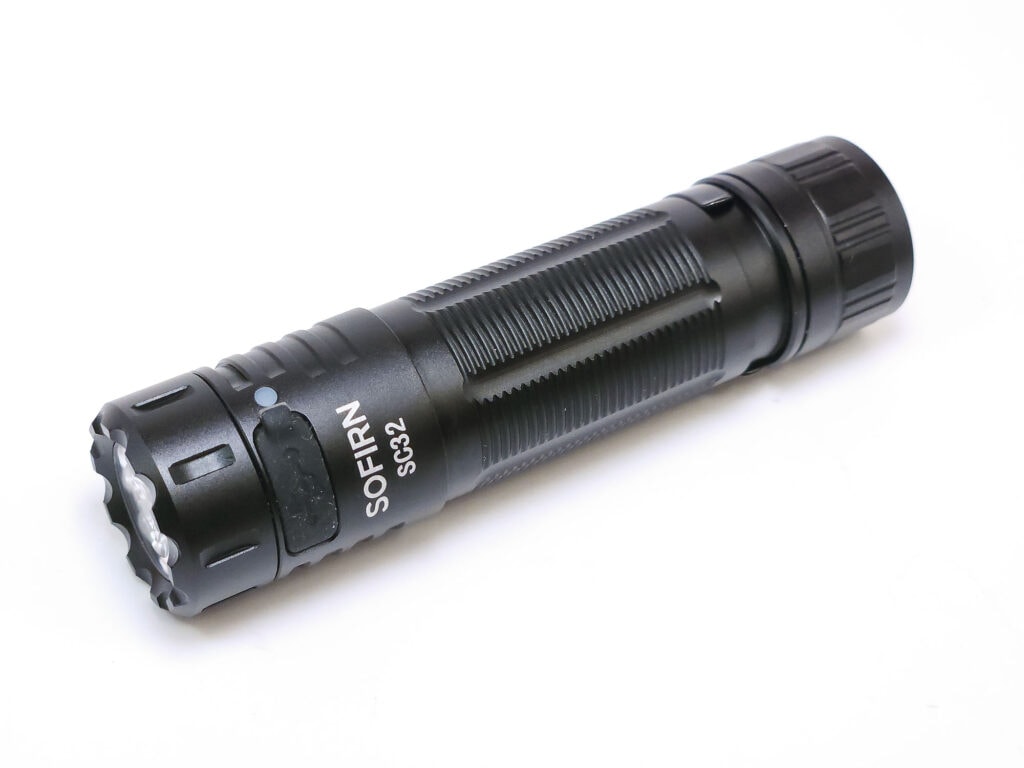
Sofirn SC32 specifications
| Brand & Model | Sofirn SC32 |
|---|---|
| Flashlight category | EDC, “Tactical” |
| LED | Luminus SST-40 6500K |
| Max. output | 2000 lumens |
| Max. beam distance | 214 meters |
| Max. beam intensity | 11,425 cd |
| Battery config. | 1*18650 |
| Onboard charging | USB-C |
| Modes | 5 |
| Blinkies | 1 |
| Waterproof | IPX8 |
| Review publication date | January 2023 |
Introduction:
Sofirn is at it again with the SC32. What can they do with an 18650-sized light that they haven’t already done, you ask? Well, the SC32 is unique in their lineup in that it has a tail e-switch (which looks very familiar), but that’s not all. Also new to Sofirn is the use of a fresnel lens! Don’t know what that means? Read on!
Package quality.
The Sofirn SC32’s box is a huge departure from the standard Sofirn packaging. Instead of the same old generic picture of someone shining a flashlight onto a tree, the SC32 comes in an all-white, thick cardboard box with magnetic closure and a sleeve. The sleeve has all of the relevant information on it: A picture of the light and key points on the front, and a description, feature list, specifications, and contact info on the back. When you slide the box out, you’ll see that it’s completely blank aside from a UPC sticker on the bottom. Upon lifting the magnetic flap, you’ll find an instruction pamphlet, the SC32 held in the cutout of a stiff foam insert, which is also white, and yet another box which contains the included accessories. This is very reminiscent of modern high technology packaging and a definite upgrade from their prior offerings.
The complete contents of the box include:
- Sofirn SC32 with clip attached and Sofirn-branded 18650 battery inside
- Instruction manual
- USB-C charging cable
- Small, plastic zip-top bag containing two spare o-rings and a generic lanyard
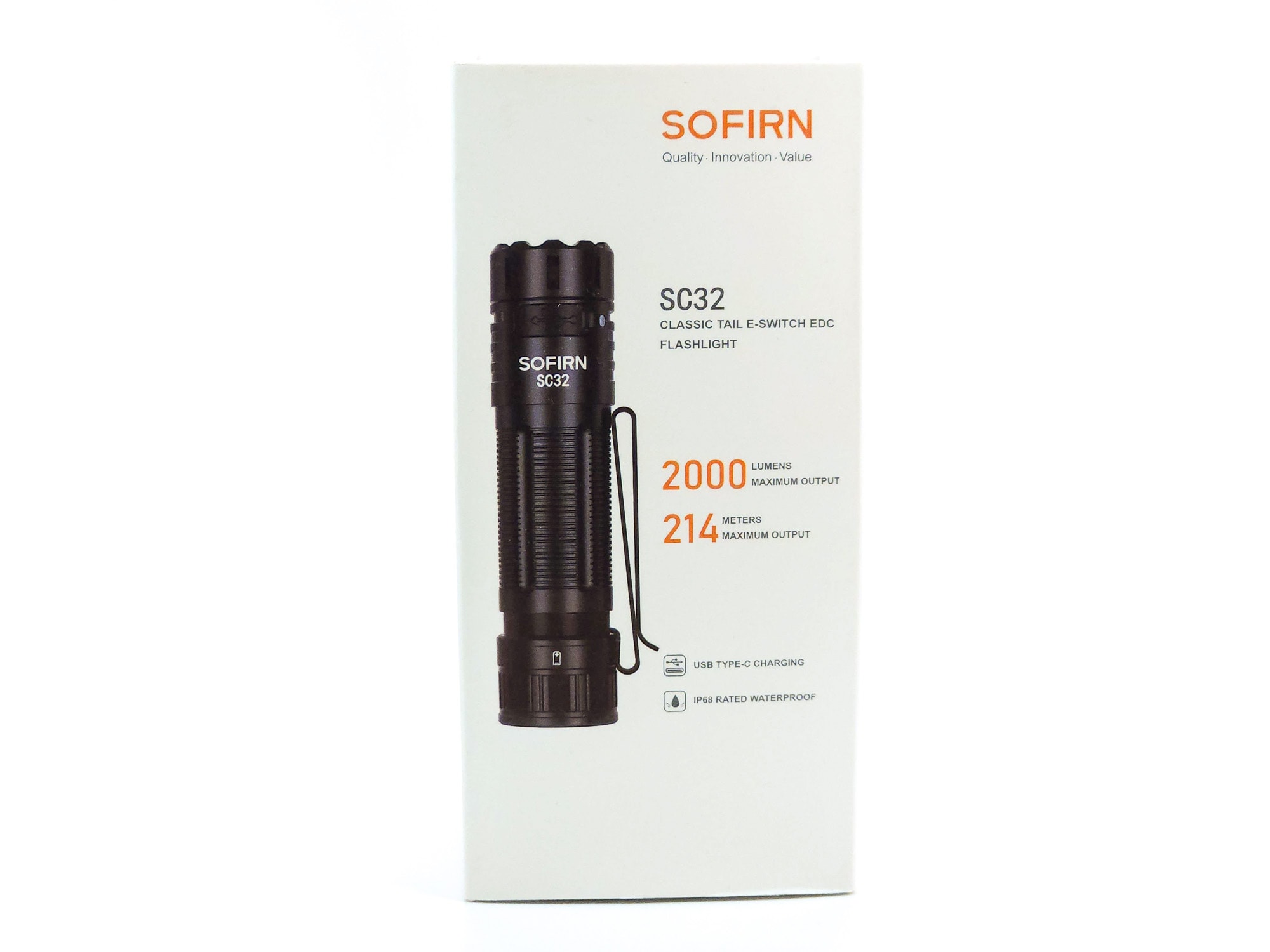
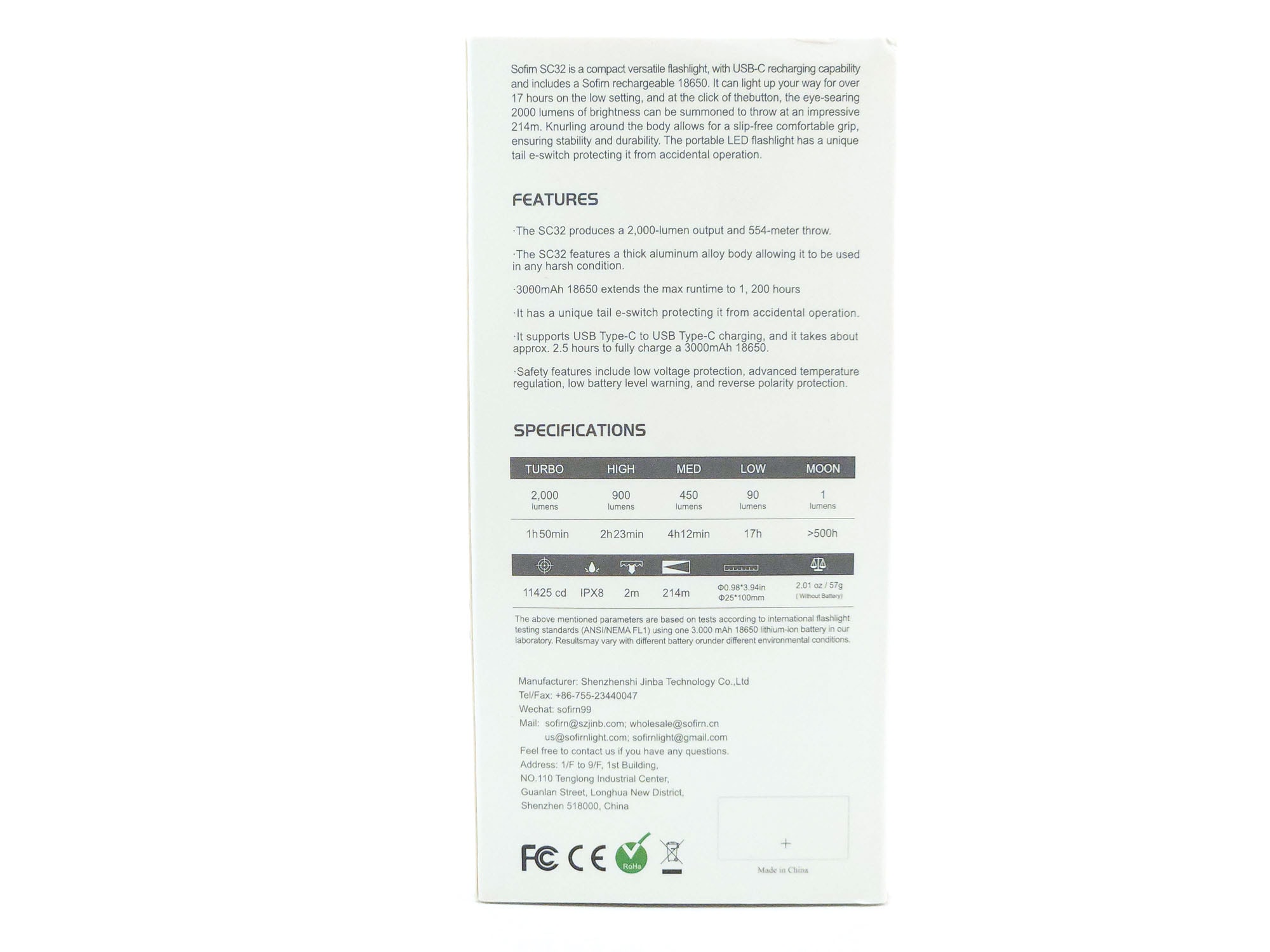
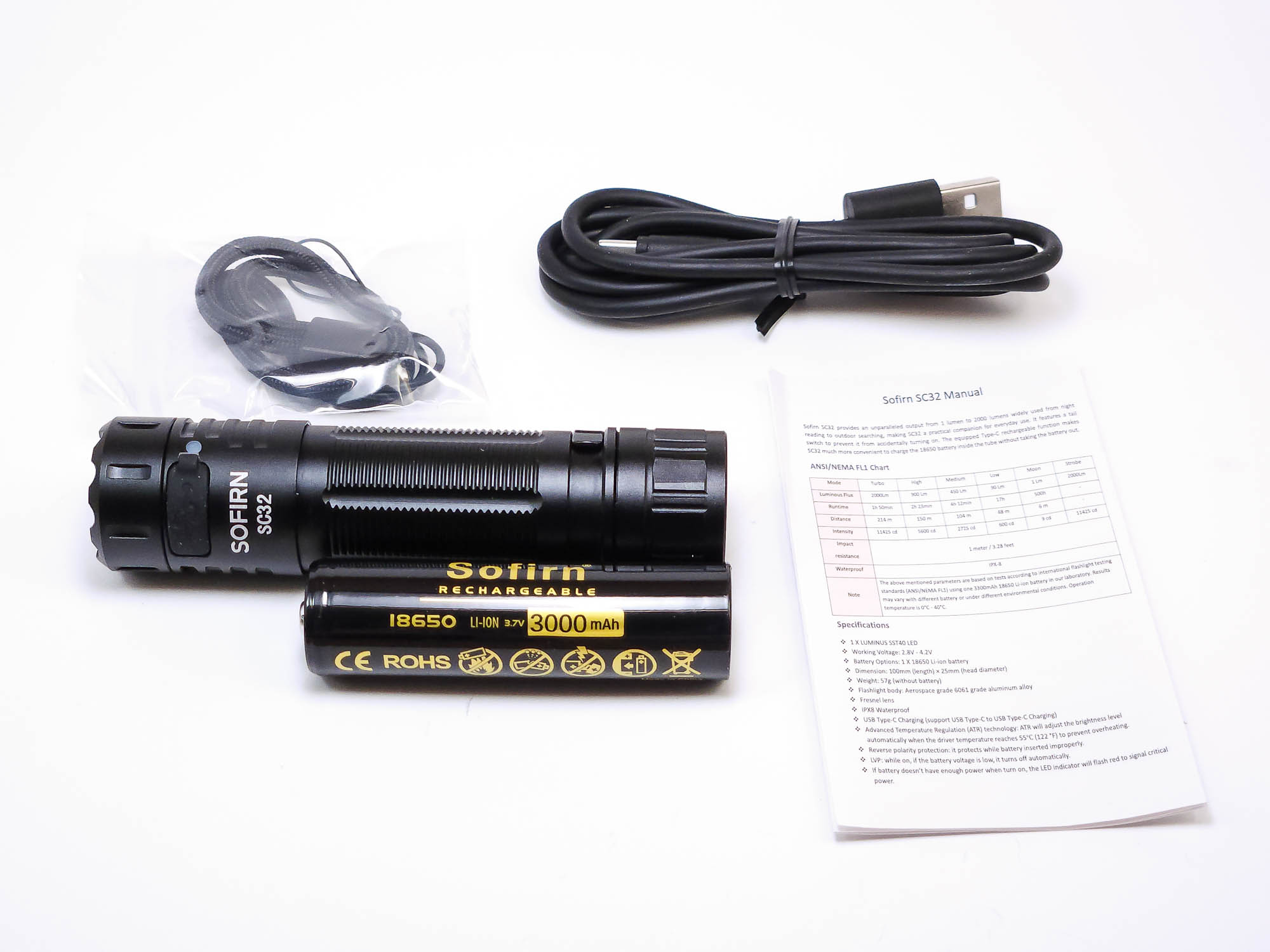
Flashlight in use
So when I got this light, I turned it on and started playing with it, as you do when you get a new flashlight, going through low, medium, and high, then to turbo, and thought I was losing my mind. I clicked it off, right? Didn’t I? But it was back in the regular group. So I tried it again. Sure enough, one click from turbo does not turn the light off, but instead goes back to the last used mode (LMH). You double-click to get to turbo, so maybe you double-click to turn it off? Nope, it goes to moonlight. THEN one click brings you back to the last used mode, THEN one click turns it off. And if that’s not enough, double-click and hold will take you to moonlight instead of turbo.
Yes, this is documented in the manual, and if I had sat down and read the whole thing before taking the light out of the box, I would’ve expected that, but this is not intuitive. Sure, there are other lights where turbo is part of the main group or you have to hold for off, but not being able to turn the light off directly from turbo is very unusual.
I took the light for a walk and wanted to keep going back to turbo as it ramped down, but I couldn’t just double-click back into turbo and couldn’t just turn it off and double-click to turbo, so it was frustrating. I kept having to look at the emitter to see if it was off or on moonlight and of course, ended up turboing myself a couple of times, but that’s my fault.
The SC32 also includes a smooth ramping mode. It takes 5 seconds to ramp all the way from one end to the other, which feels like a long time. I timed a few other ramping lights, both with and without Anduril, and all the others took around 2-3 seconds for a full ramp. It’s actually nice because you can select levels lower than the 90-lumen low that’s included in the stepped mode, though that can be a bit of a challenge with how quickly it ramps past that level. Also, it appears to ramp all the way to turbo, as when I double-click at the top of the ramp, there is no change in brightness, and it acts the same way when you click or double-click at that point.
When ramping, if you click and hold within 1.5 seconds of when you stopped ramping, it will ramp in the other direction. This is fairly normal, but what I discovered was that after that 1.5 seconds elapses, whatever direction you were ramping in is memorized and when you go to ramp next time, even after you turn the light off, it will ramp in the same direction. Most lights with ramping will always start ramping up and ramp down when you ramp up briefly, then hold again, or double-click and hold. But if you ramp down and use the SC32 for more than 1.5 seconds without ramping up, the next time you go to ramp, you will be ramping down again.
As you can hopefully understand by this point, here’s where I disagree with Sofirn a bit. They’ve labeled the SC32 as a “tactical” flashlight. Just because it has a tail switch does not make it “tactical.” “Tactical” implies usage in combat, and if you’re in a situation like that, you don’t have time to be messing with modes. Generally speaking, a true tactical flashlight will have minimal operation and minimal modes. Operation is handled by a forward-clicky mechanical switch. You turn it on to see, you turn it off when you don’t want to be seen. Maybe strobe in there, too. Maybe a second, lower mode that’s not in the way of the high/turbo mode. The SC32 not only has a full set of modes, but they’re selectable with its electronic switch. While this setup is fine for an EDC light, it’s quite the opposite of what a tactical flashlight is, especially with the dance needed to turn it off from turbo.
So if not tactical, then what? I would say it’s ok for EDC. In fact, I would even suggest using the ramping mode over stepped as there’s more option in light levels and you don’t necessarily have to deal with all the clicking to get out of turbo by ramping up all the way. I do like that it’s shorter than many other 18650 lights, especially those with tail switches. That compactness makes it easy to pocket.
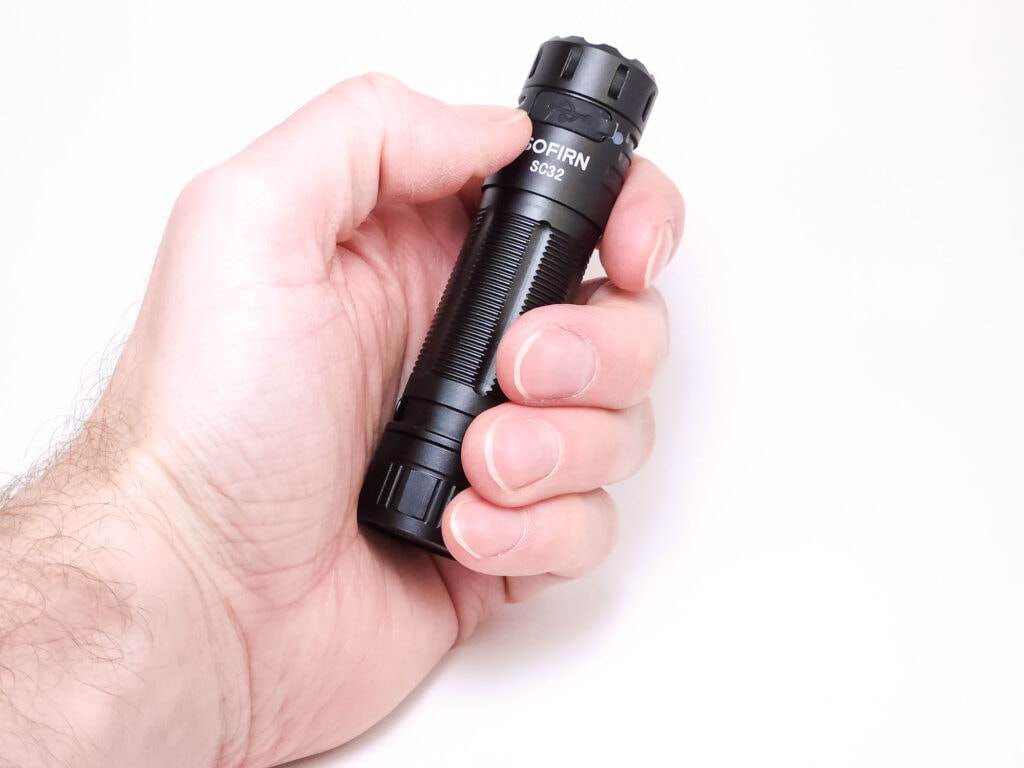
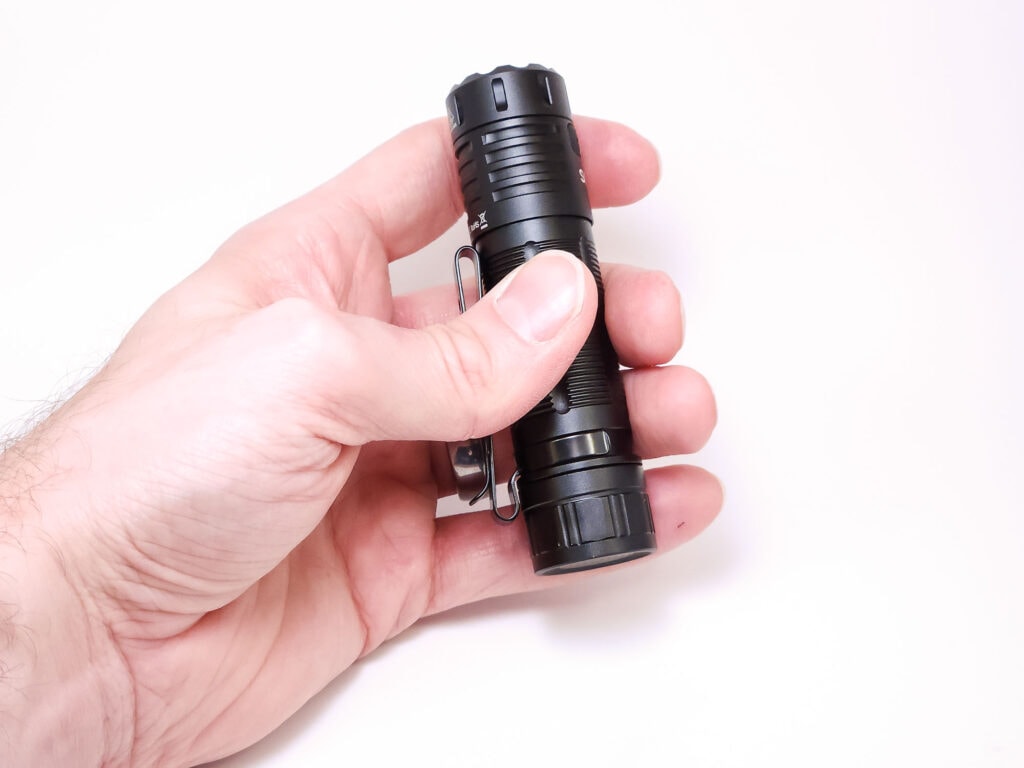
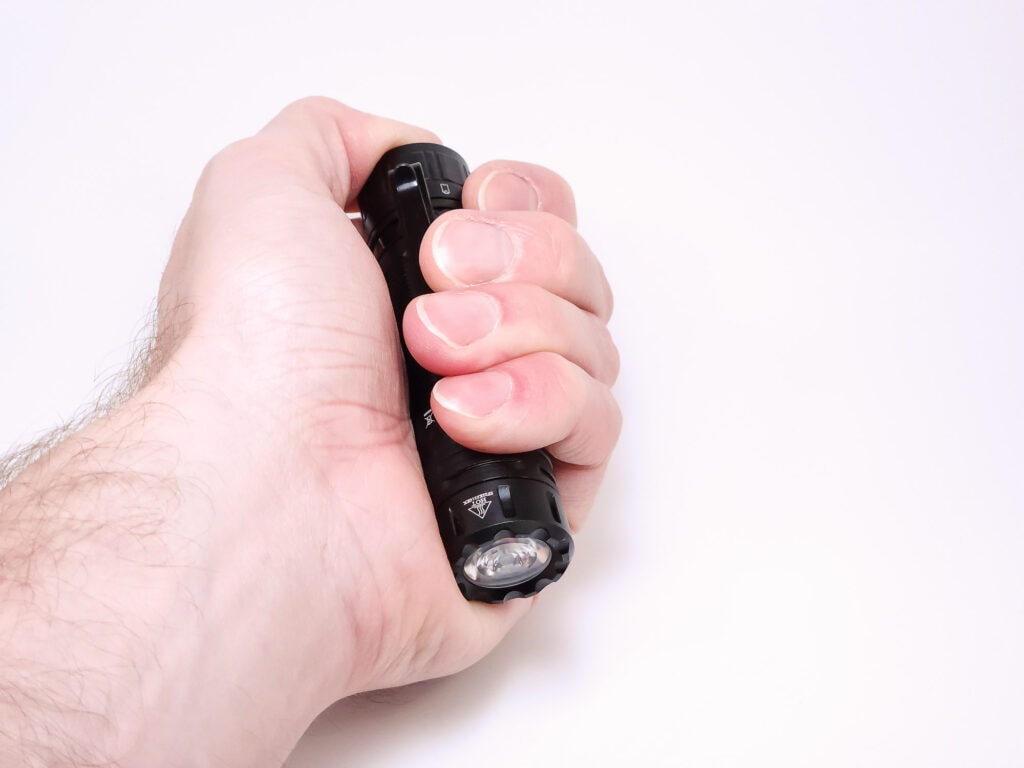
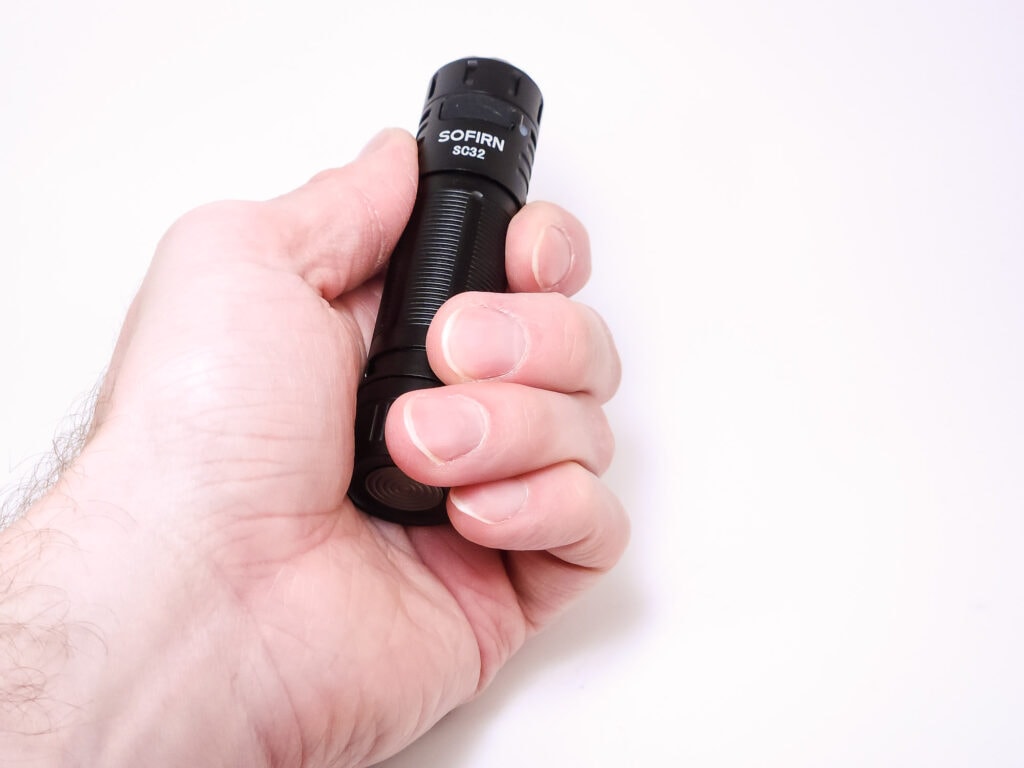
Build Quality, and Warranty
Machined from black anodized aluminum like most of Sofirn’s lights, the SC32 feels stout. That might seem like a weird way to describe it but the way it’s so compact combined with there only being a slight difference in the diameter of the tube and head just give it a real solid feel. However, if you smack it, the battery will bang against the tube wall slightly, though I was unable to get it to disconnect. The dual springs see to that.
For knurling, the tube has horizontal rings along much of the body, with vertical cutouts interspersed throughout. Despite this pattern, it actually feels kind of slippery if you move your fingers across it, though I didn’t really find that to cause a problem with grip. At the rear of the tube, there’s a groove for the included and attached two-way clip. This is the only groove like it so the clip cannot be attached in any other way. On the other side of the tube, the threads for the head are unanodized, so mechanical lockout is not possible on this light.
But what about the threads on the tail, you ask? Unlike most lights, the SC32 has the tail cap glued on instead of the head, so that prevents mechanical lockout on that side, too. Which brings us back to the e-switch. Have you figured out where you’ve seen this switch before? That’s right, the Wurkkos TS10. It works the same way, too, so if you like or hate the switch on the TS10, you’ll already know what you’ll feel about it on the SC32. Wurkkos did specifically call out that you should not disassemble the tail cap on the TS10, which would explain why it’s glued down on the SC32. The tail cap itself has an interesting design that might count as knurling on it, though it’s not really necessary to get a good grip on the tail cap itself, due to it being glued down.
On the other side of the light, the head has some cooling fins cut into it, which are identical to those found on the Wurkkos TS10. That’s where the comparisons end, I promise. In another interesting move, the USB-C charging port is on what I consider to be the front of the light, above the make a model markings. The SC32 has a narrow rubber cover for the port, unlike other Sofirms which have a larger square cover. It fits fairly snugly, but is not too difficult to remove when you need to charge. Next to the charging port is a status light which stays on for 5 seconds when you first turn the light on, displaying in green when charge is good, solid red when it’s low, and flashing red when it’s critical. It also flashes red while charging.
Surprisingly, the bezel is not glued down. Not only that but the threads are lubed. Usually manufacturers don’t want you getting into the bezel, but on the SC32 it’s wide open, meaning emitter swaps will be a breeze.
The bi-directional clip that comes with the SC32 holds tightly onto the body, but I would describe the actual clip portion of it as springy. As I’ve carried it around in the front pocket of my pants, it has a tendency to drift away from the side where I’ve placed it more towards the middle of the pocket because it doesn’t grip the pocket as strongly as other clips do. The ends are wide, so it will fit nicely on thick fabric or the brim of a hat. There was one time that the clip snagged on the vacuum hose while I was doing chores and it bent the outer arm out, which was disappointing, even though I was able to squeeze it back into place with some pliers.
The other accessory it comes with is a lanyard, but the only place to attach it is onto the end of the clip, which is closer to the head than it is to the tail. This sort of makes sense, as it allows you to rotate the light between standard and overhand grips, but it doesn’t really allow for the cigar hold, and you wouldn’t want it dangling by this.
I do have one minor irritation about this light, and that’s that none of the markings line up. On the front of the light we have the make and model, while opposite that are some regulatory markings, but those are slightly off center. The rear of the bezel features a HOT warning and serial number, but these are also ever so slightly off center. If I could tighten the bezel down just a little bit more, they’d line up. Finally, there’s also a battery symbol on the tail cap, indicating the direction the battery should be inserted (positive terminal towards head) which is the most skewed of all (not to mention the fact that the battery isn’t inserted through the tail since it’s glued down!). Thankfully, these three are on the rear of the light on my unit and are not visible when you’re looking at the front of it. Your mileage may vary, due to differences in threading.
I did encounter one problem while using the SC32. One time I turned it on and it stopped responding. The green status light would not go off, even well after 5 seconds had passed, and it would not accept any button presses. I had to unscrew the head to turn it off, but then it went back to working. Other than that, it’s worked fine.
Sofirn’s standard warranty applies to the SC32:
Within 30 days of purchase: Contact the original seller for repair or replacement.
Flashlights: Within 1 year of purchase: Contact Sofirn for repair or replacement
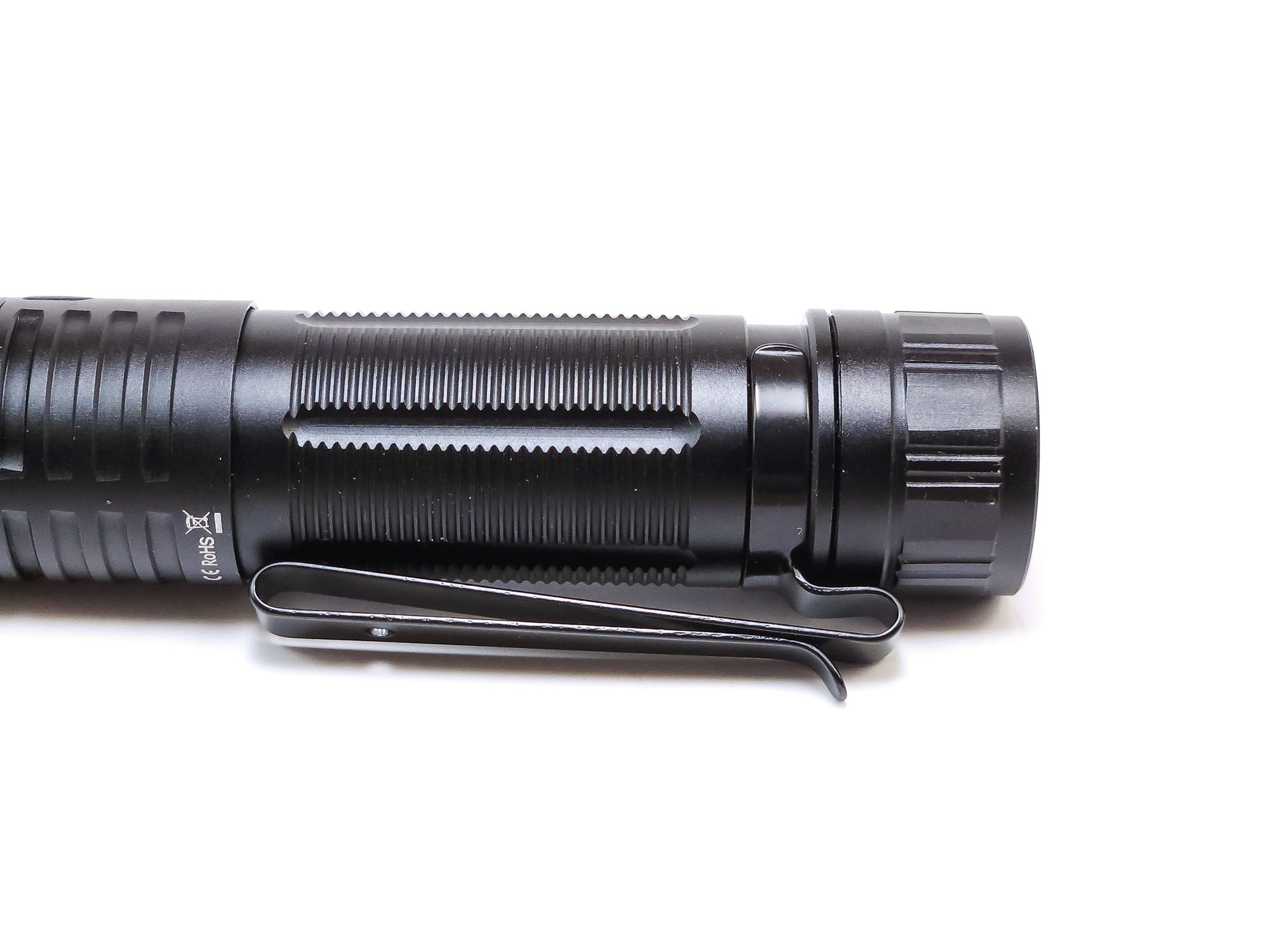
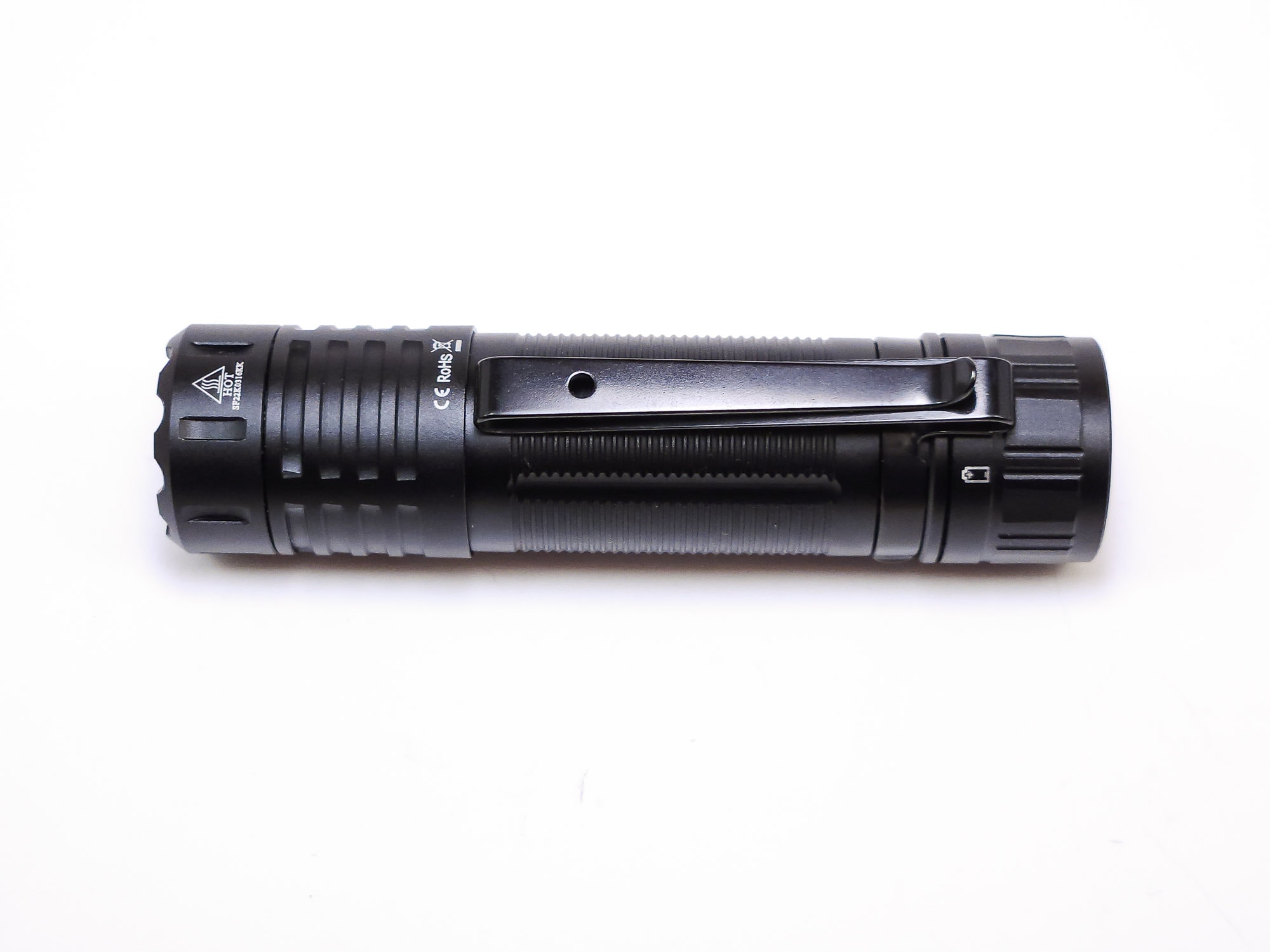
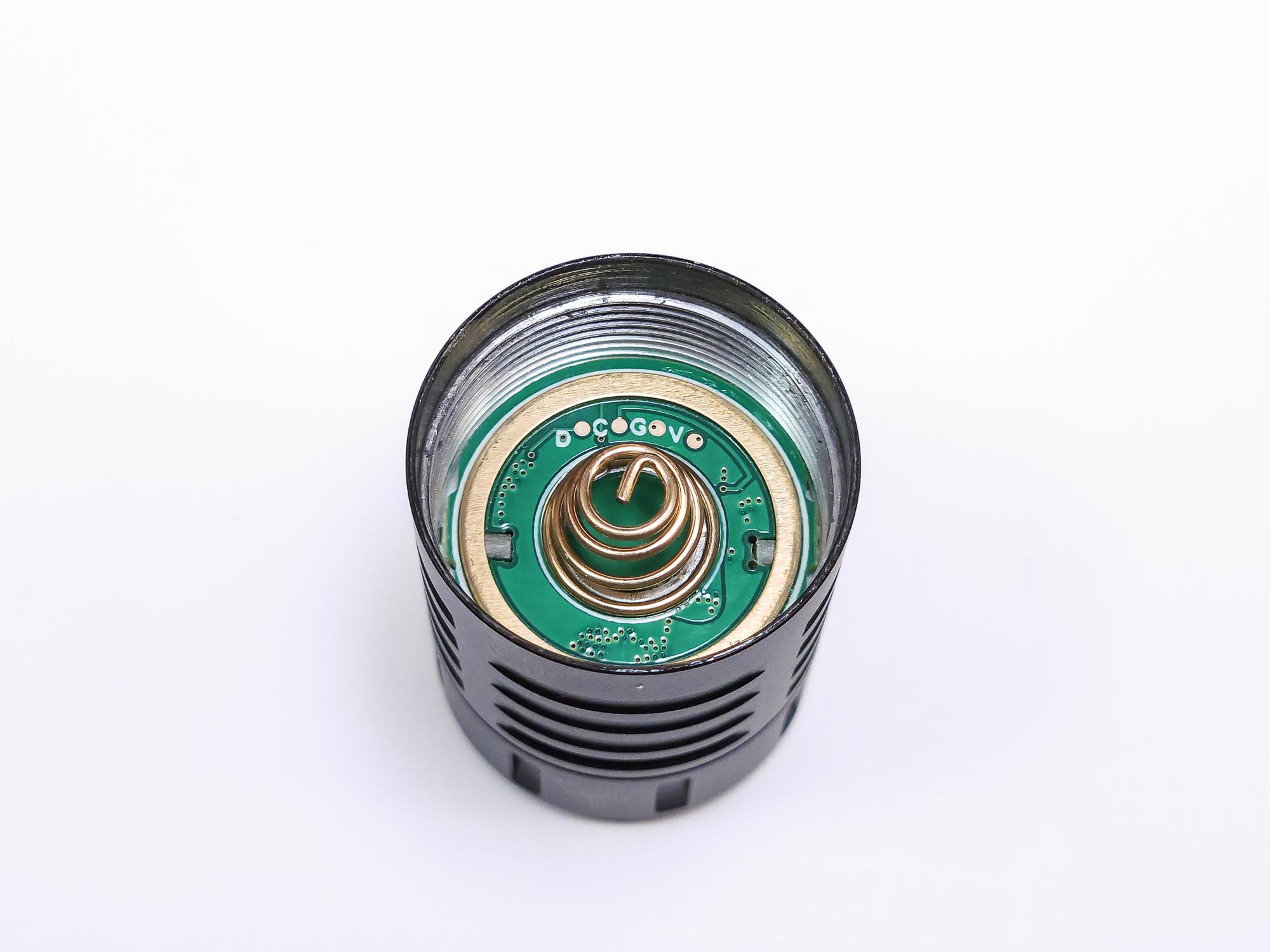
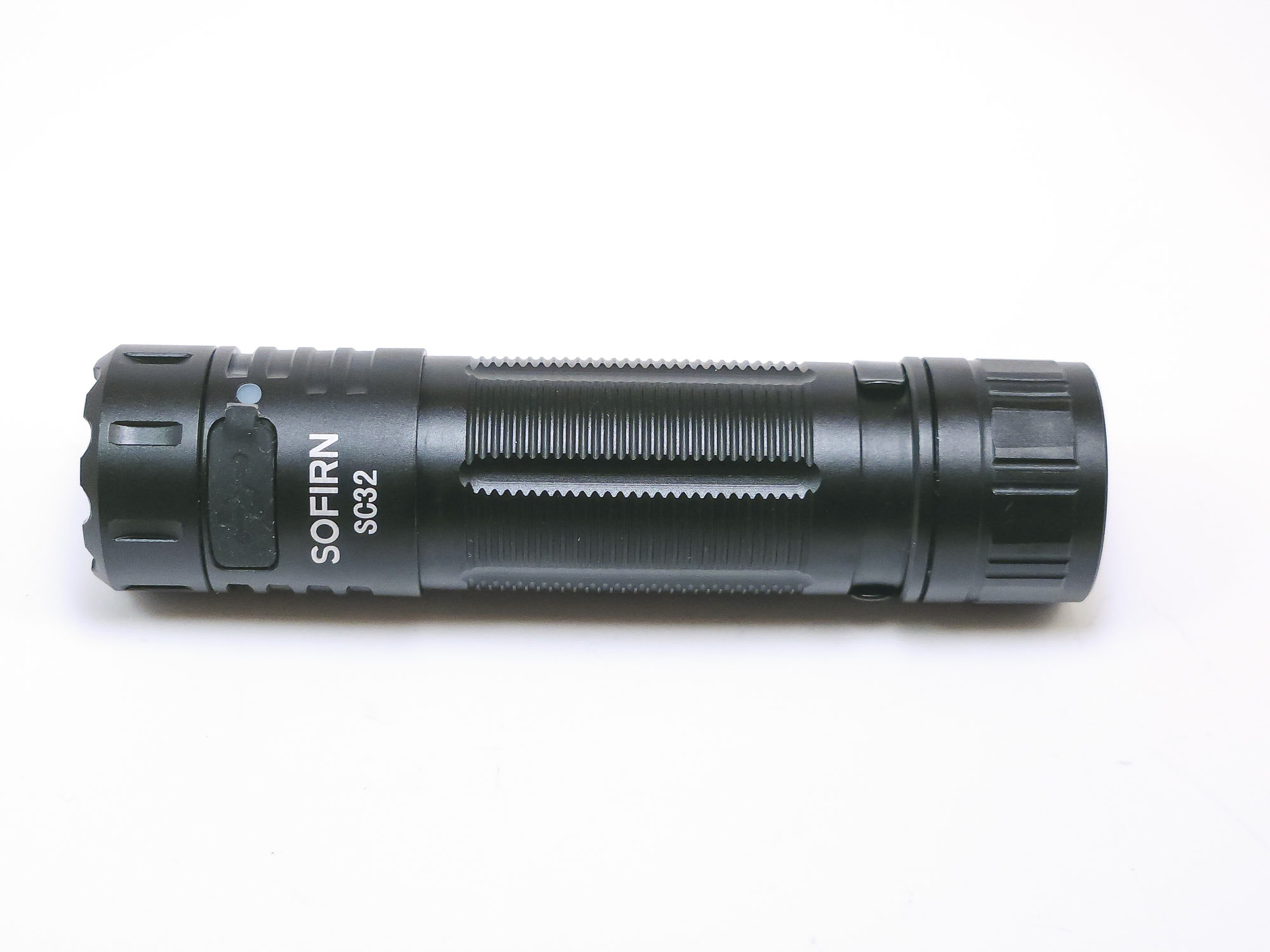
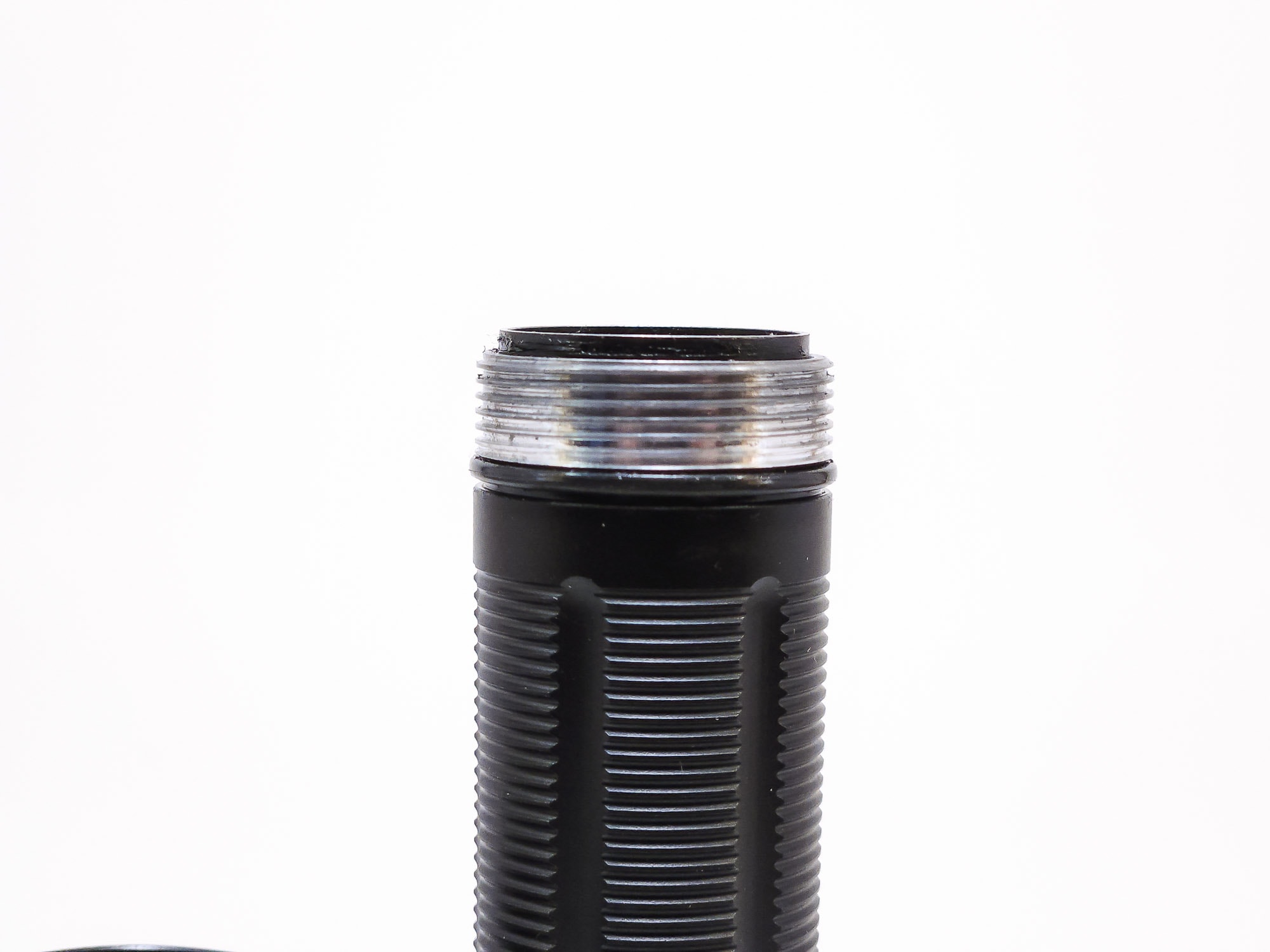
LED, Lens, Bezel, Beam, and Reflector
Here’s where things get a little interesting. Under the crenulated bezel, the SC32 uses a fresnel lens not commonly seen on flashlights. In a nutshell, the fresnel lens does the job of a convex lens by dividing up the curvature of the lens over a number of lower-profile concentric rings. This allows the lens to be flatter, saving space and material. Since this fresnel lens is shorter than standard TIR lenses or reflectors, it helps keep the light short. There’s no glass lens to cover the plastic fresnel lens, so that may shorten the overall length as well, but then the plastic lens is exposed, so keep that in mind.
The fresnel lens directs light forward, increasing throw at the expense of spill. and producing a medium-sized, indistinct hotspot. That’s not to say there is no spill; there’s strong spill immediately around the hotspot, but it quickly fades as the distance increases. One other interesting aspect of this setup is that it produces two full-spectrum rainbow halos around the spill. You may find this distracting.
Unfortunately, no review of a light which uses an SST-40 would be complete without mentioning how green it is. As always, the light gets less green and more white as the power increases, but even on turbo it’s well above the BBL. My Opple Light Master Pro measures the CCT between 5400-5700K despite the emitter being 6500K.
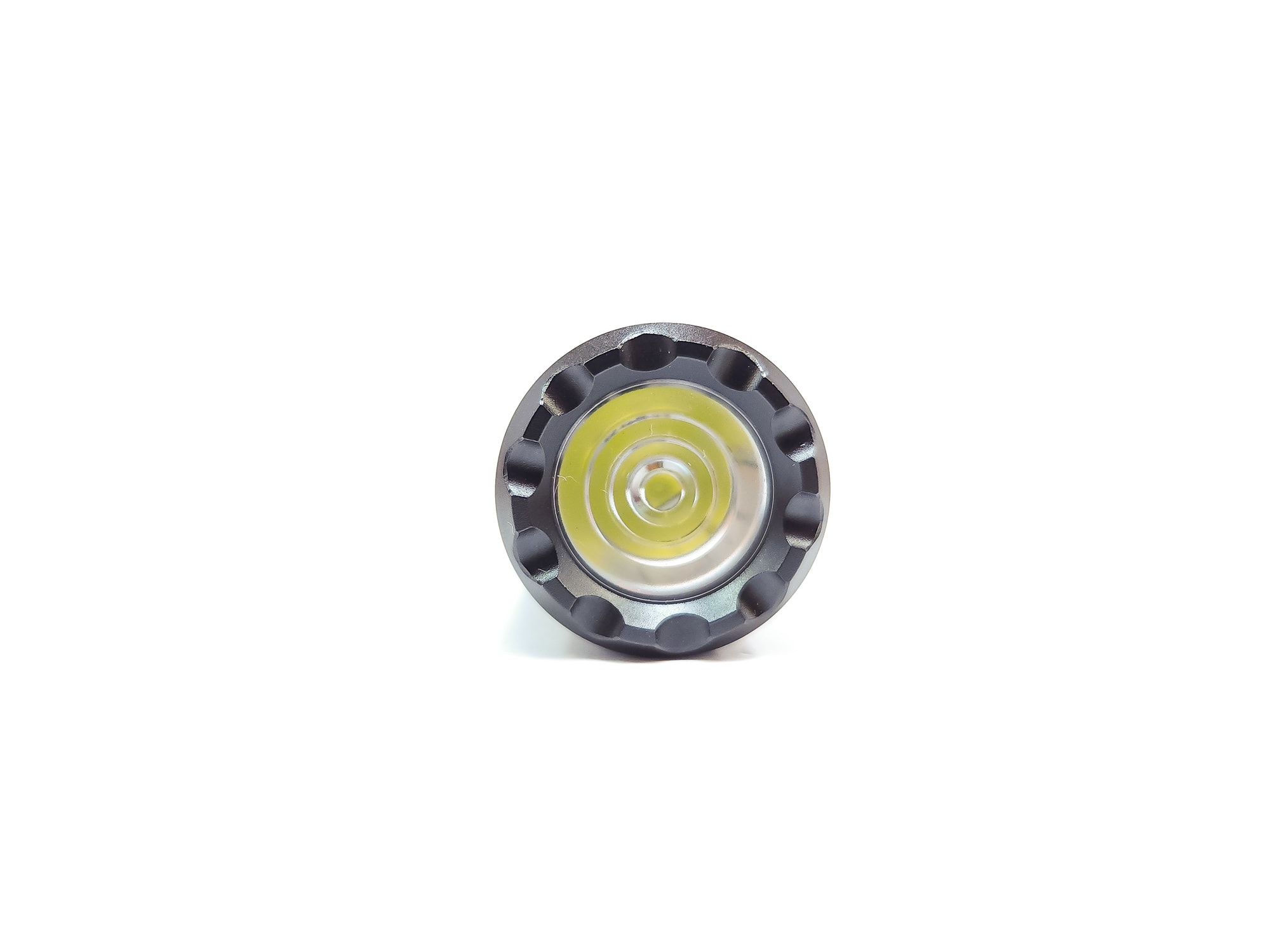
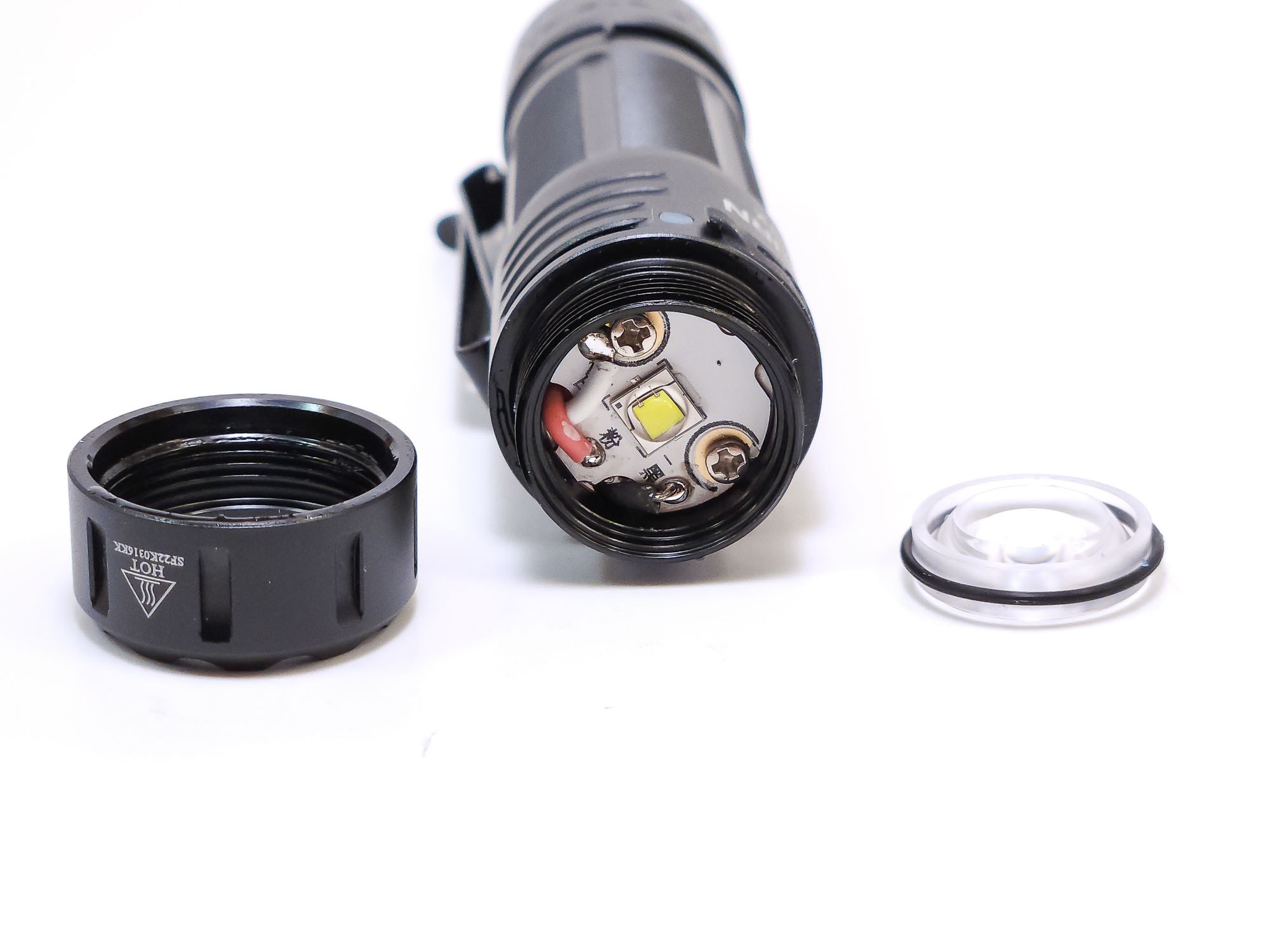
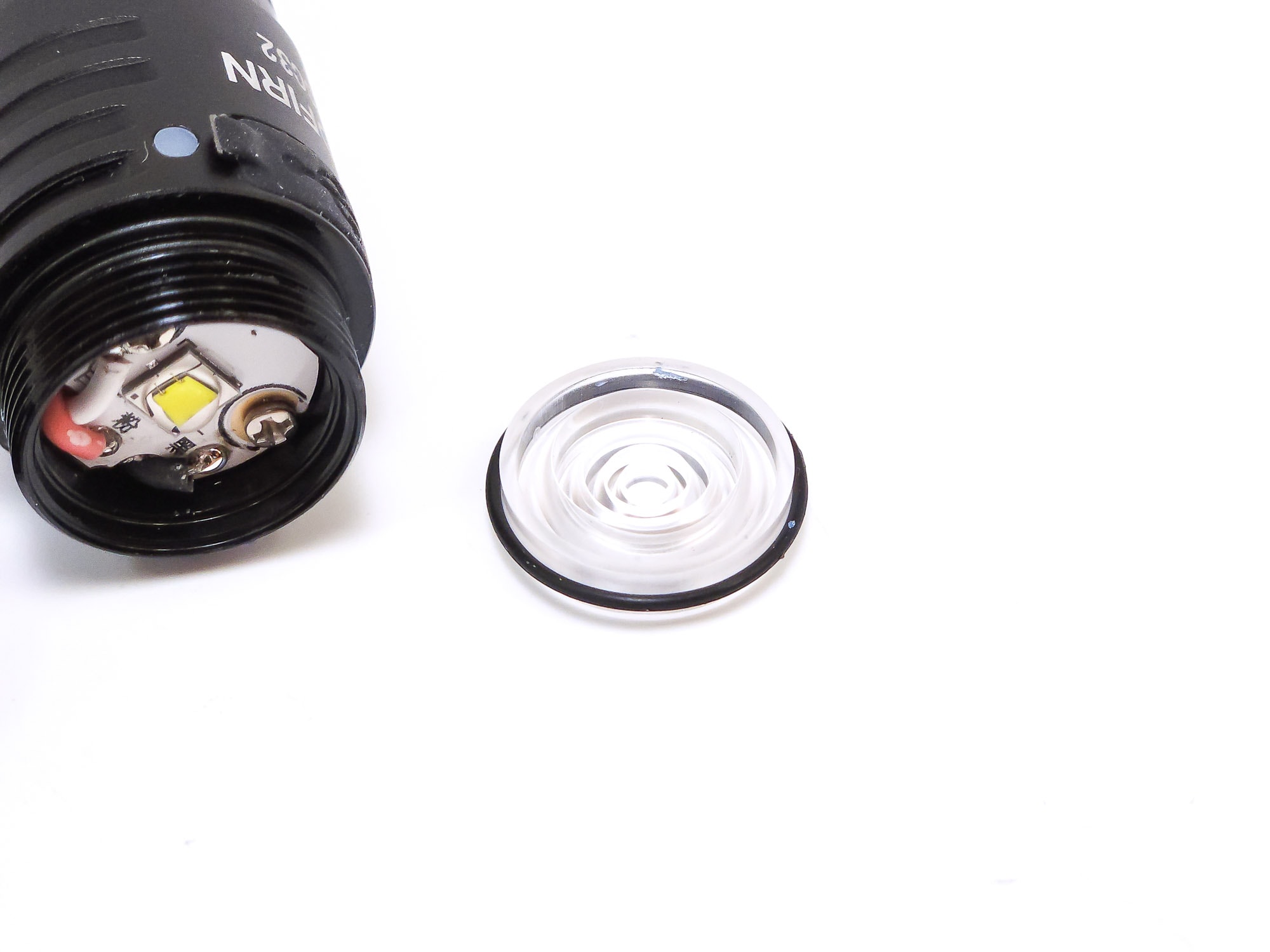
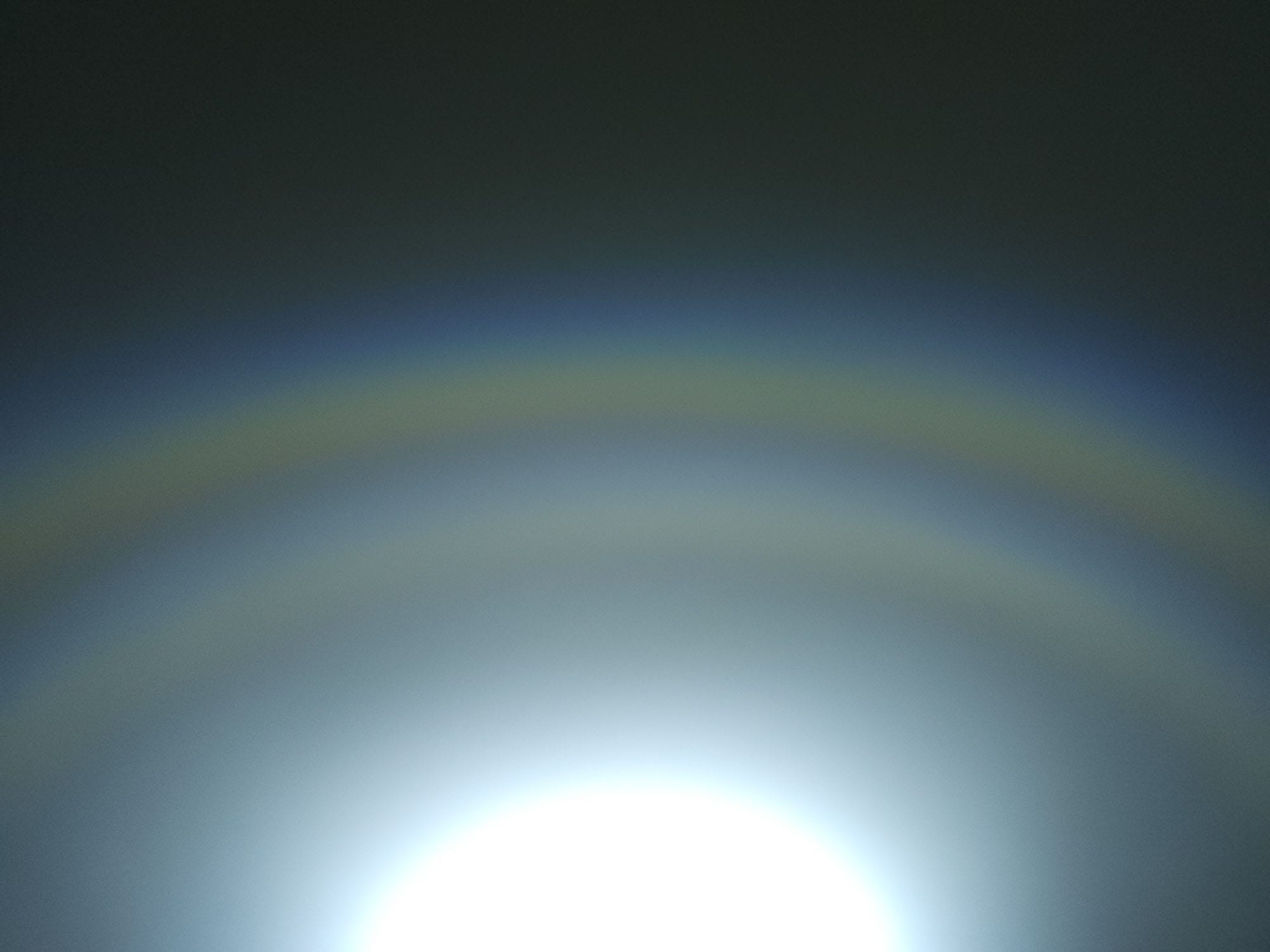
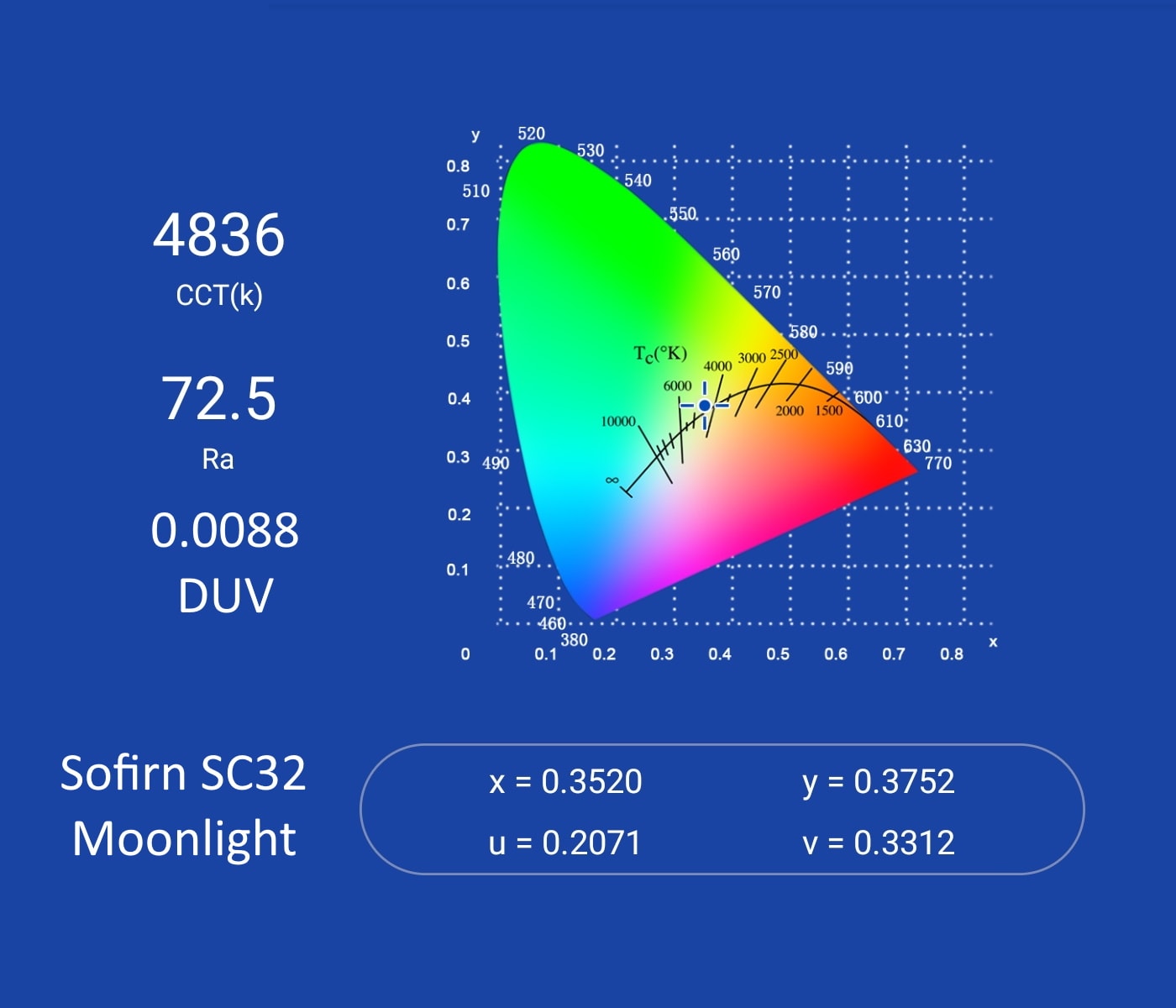
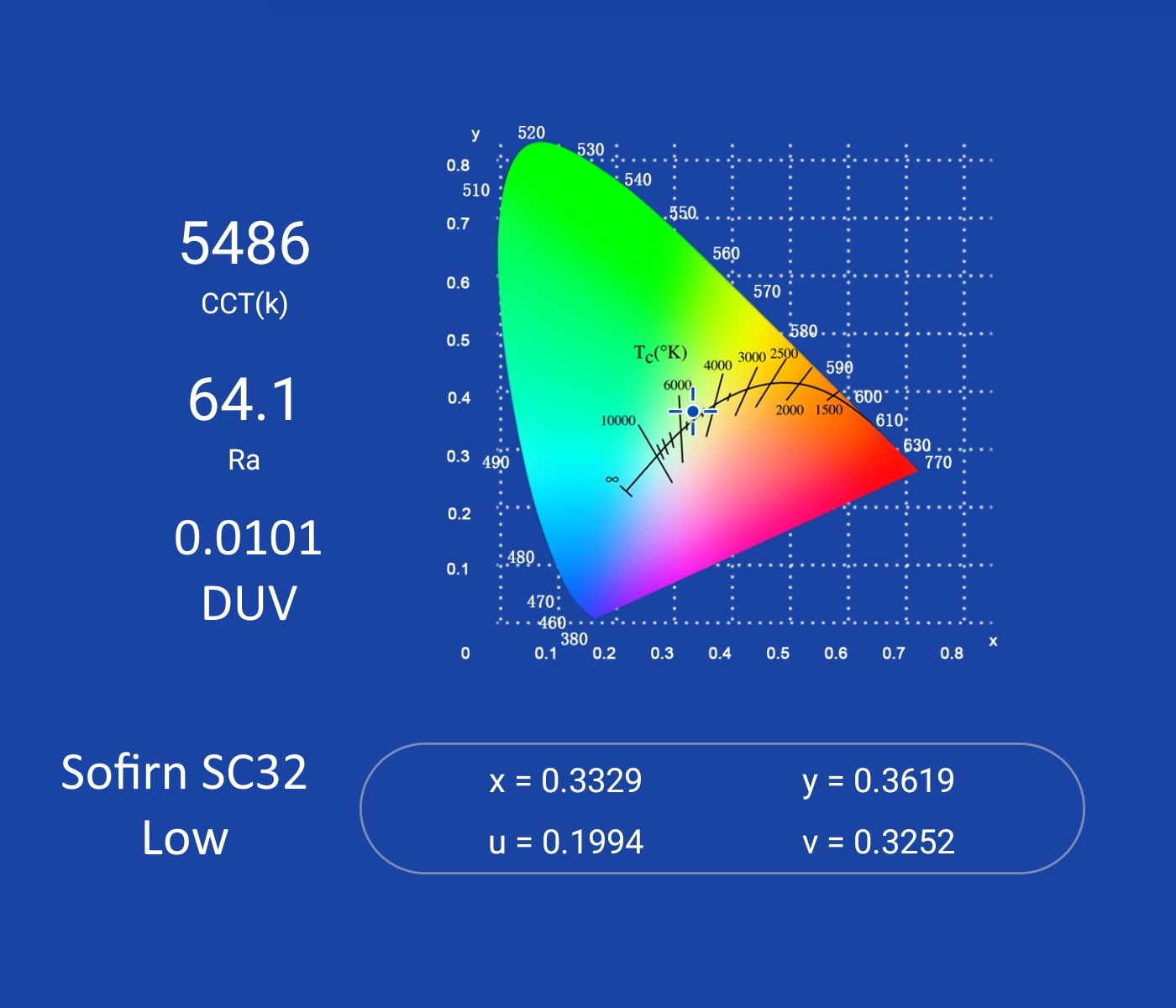
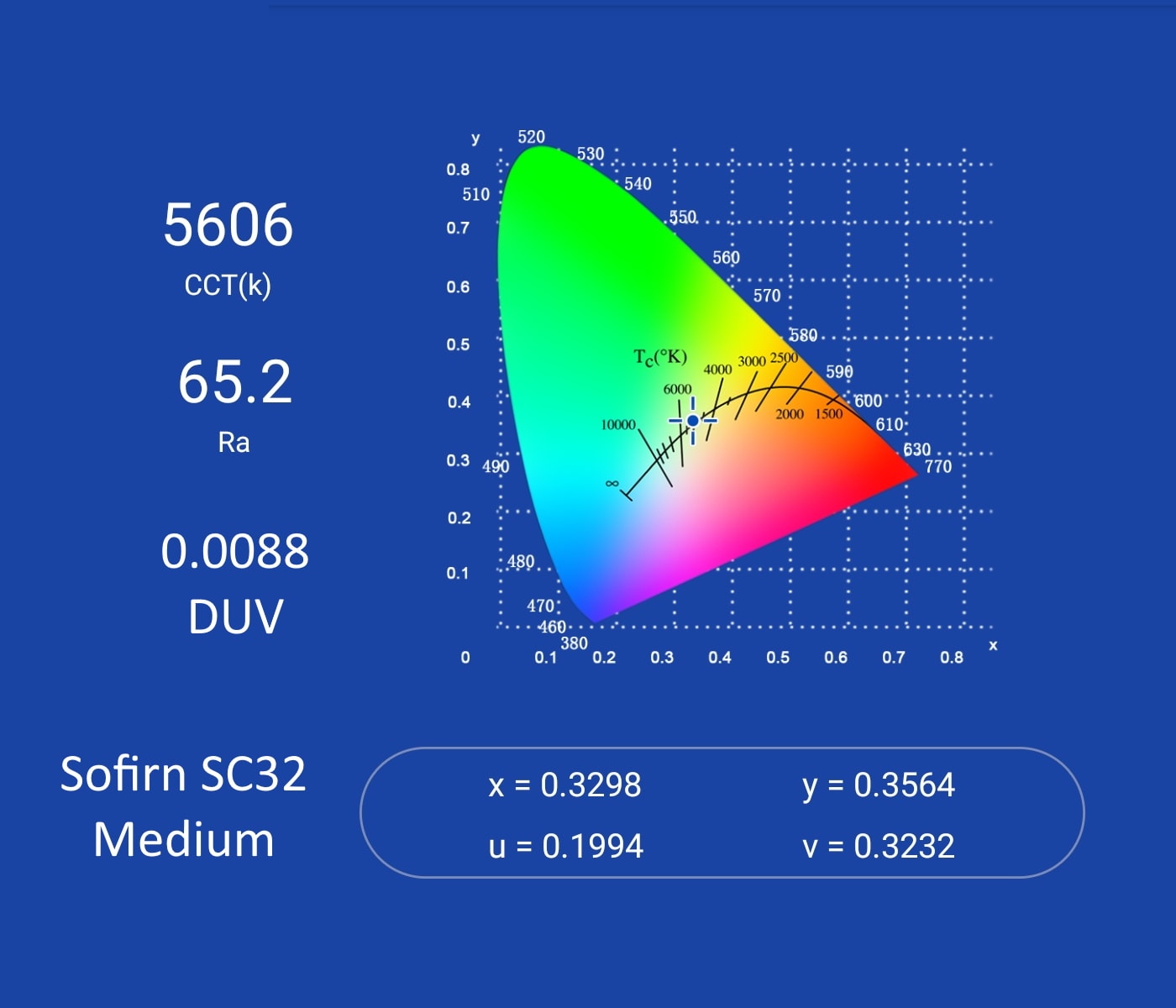

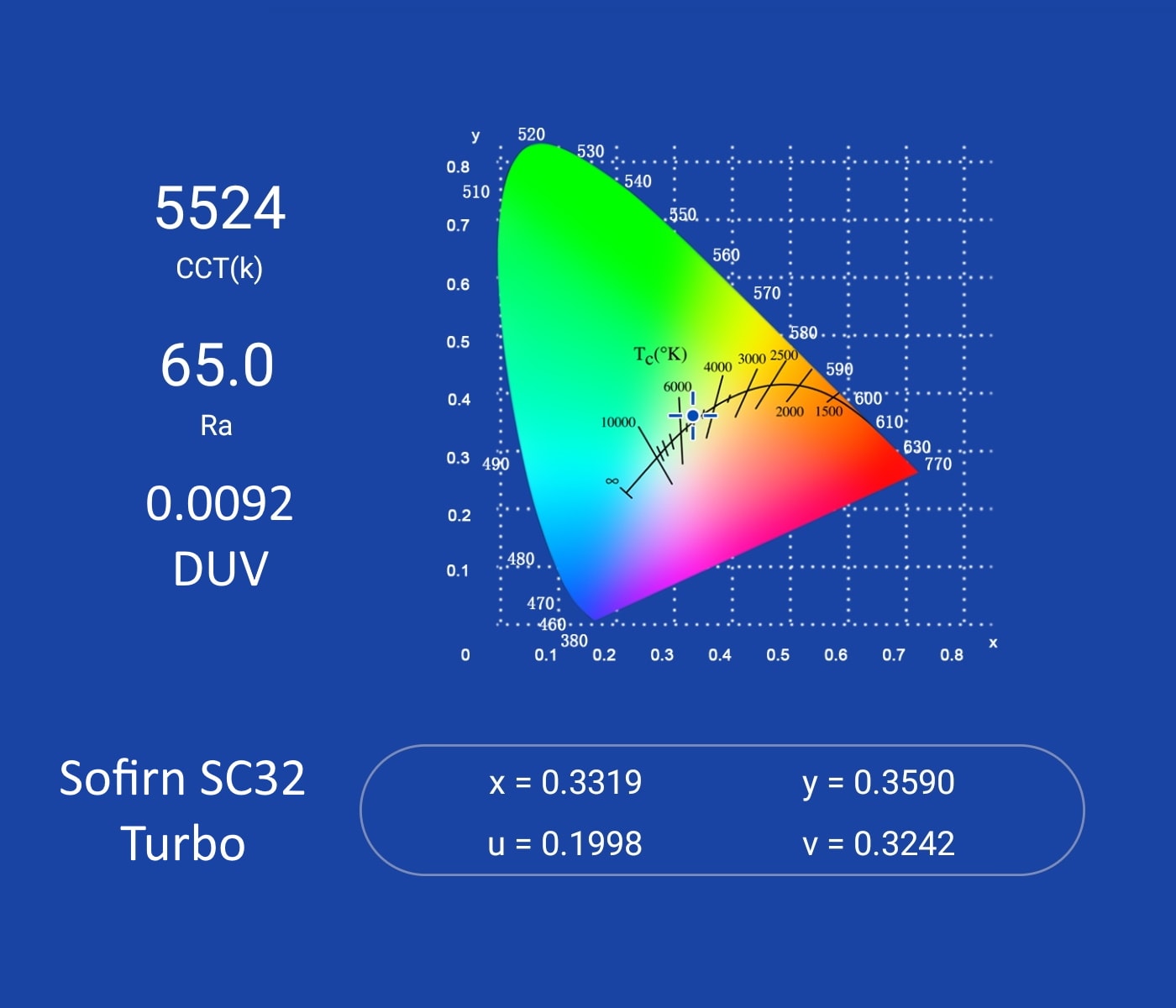

Dimensions and size comparison
Dimensions:
| Sofirn SC32 | Millimeters | Inches |
|---|---|---|
| Length | 100 mm | 3.9 in |
| Head diameter | 25 mm | 1.0 in |
| Body diameter | 23 mm | 0.9 in |
Dimensions are rounded to the nearest millimeter, and to the nearest tenth of an Inch.
Weight:
| Sofirn SC32 | Weight in grams | Weight in oz |
|---|---|---|
| Without battery: | 58 g | 2.0 oz |
| With battery | 104 g | 3.7 oz |
Weight is rounded to the nearest gram, and to the nearest tenth of an Oz.
Flashlight size comparison with its competition:
As you can see, it’s pretty compact!
Group 1: Sofirn SC18, Sofirn SC32, Sofirn SC31T Pro
Group 2: Emisar D4V2, Sofirn SC32, Convoy S2+
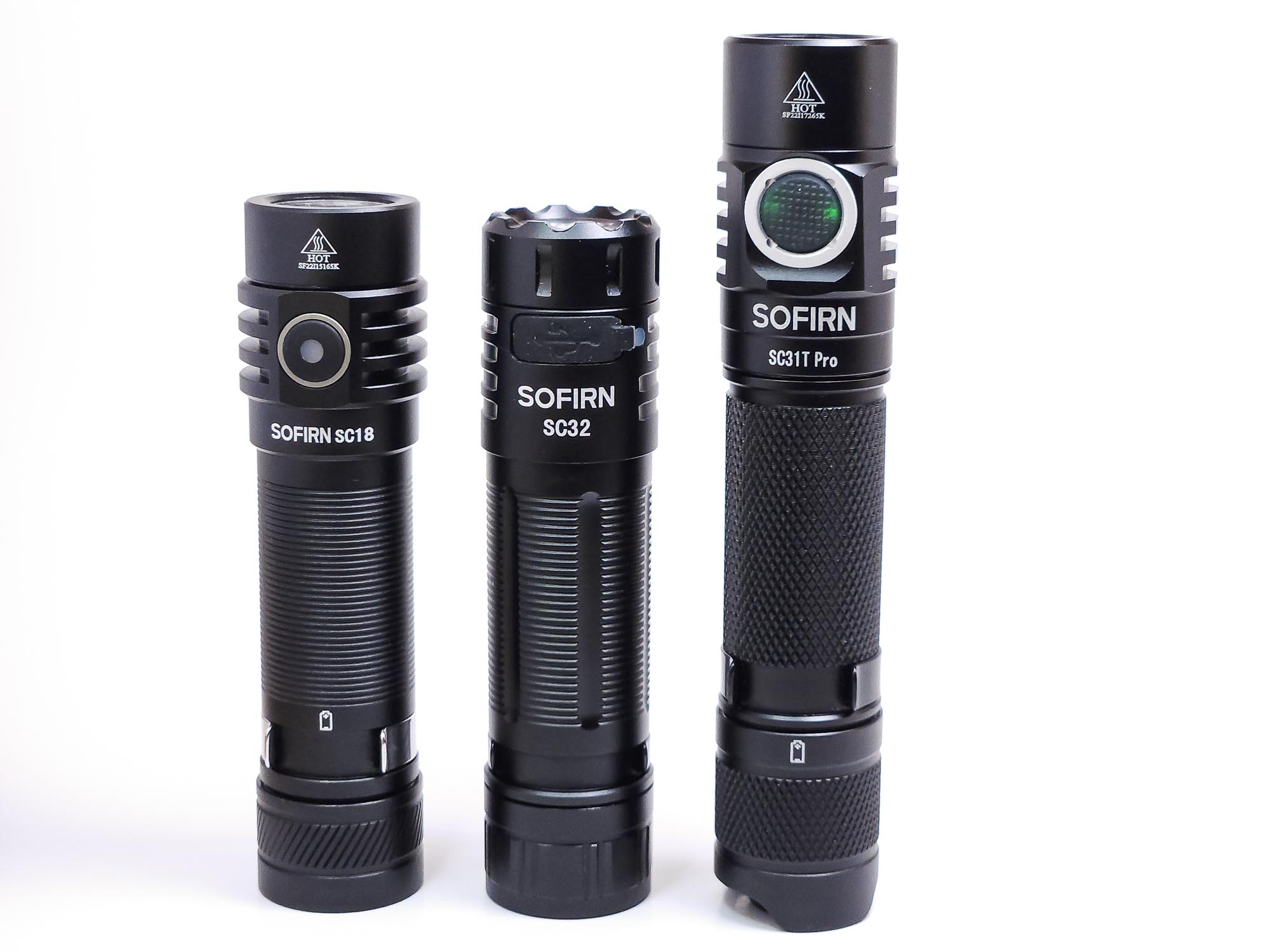
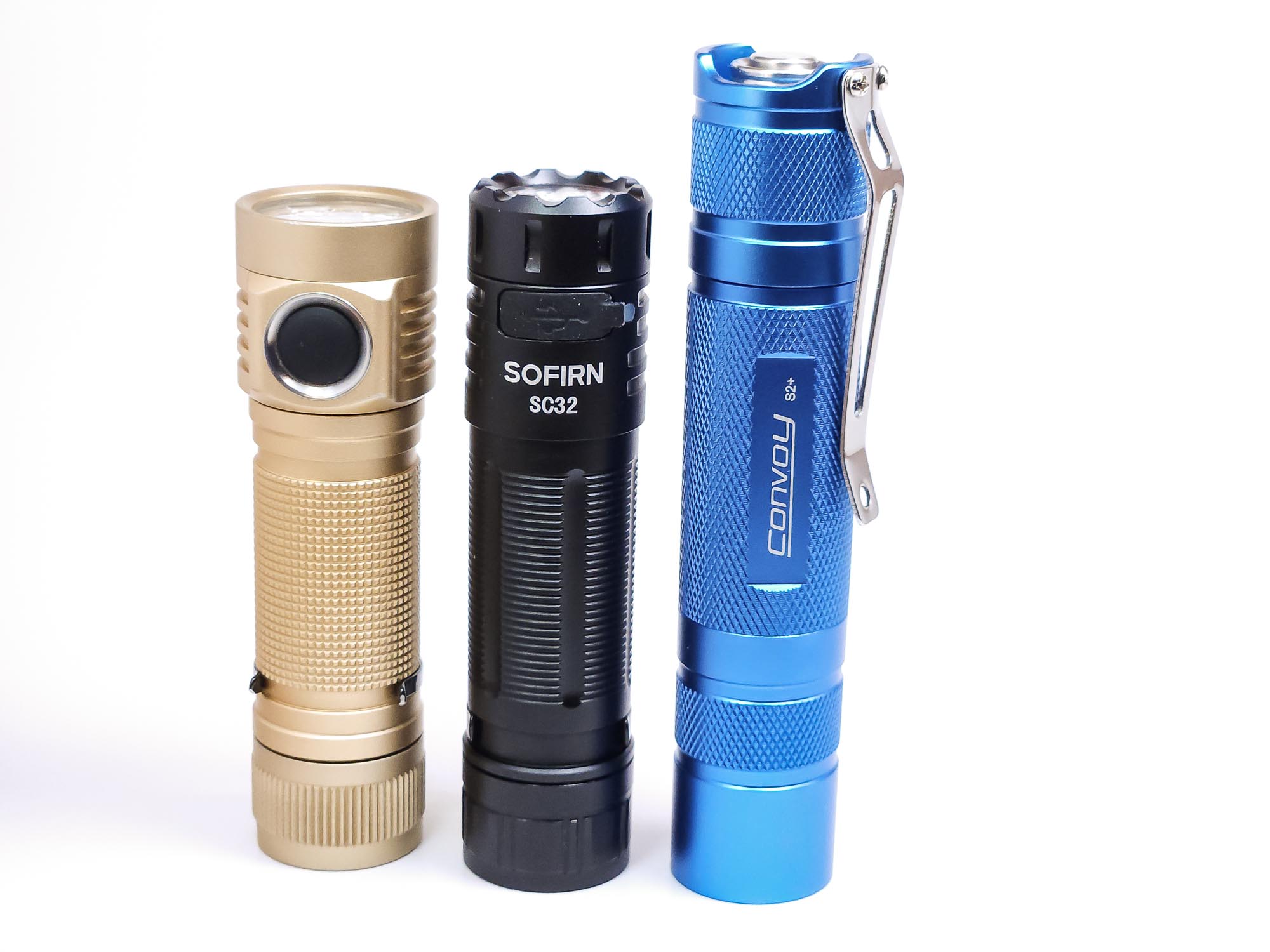
Driver & User Interface:
The SC32’s UI is fairly simple and standard.
Available modes:
- Moonlight, low, medium, high, turbo
Available blinky modes:
- Strobe
From OFF:
- Press and hold: Moonlight
- Single click:
- Stepped: Memorized LMH
- Ramping: Last used level
- Double click: Turbo
- Double click and old: Moonlight
- 3 clicks: Strobe
- 4 clicks: Lockout
From ON:
- Press and hold:
- Stepped: Advance LMH
- Ramping: Ramp up/down
- 1 click: Off
- Double click: Turbo
- Double click and old: Moonlight
- 3 clicks: Strobe
- 4 clicks: Toggle between ramping and stepped
Mode memory:
- The SC32 will memorize the last used LMH level
Shortcuts:
- To Moonlight: Hold from off
- To Turbo: Double-click
- To Strobe: Triple-click
Low voltage warning:
- The indicator light next to the charging port will blink red when the battery gets low
Strobe/blinkies
- There is only one strobe, and it’s accessed by a triple-click.
Lock-out mode:
- 4 clicks from off will lock and unlock the light
- Clicking while locked out will cause the light to blink, indicating it’s locked out, but it’s pretty bright.
- You can use momentary moonlight while locked out!
PWM
- Not visible by the naked eye or camera.
Additional/summary info on the UI:
- As I mentioned above, the real challenge is exiting turbo.
- From turbo:
- Single click: Memorized LMH
- Single click: Off
- Double click: Moonlight
- Single click: Memorized LMH
- Single click: Off
- Single click: Memorized LMH
- Single click: Memorized LMH
- Also, ramping can be confusing:
- From on
- Hold: Ramp up/down
- Hold within 1.5 seconds: Ramp opposite direction
- Hold after 1.5 seconds: Ramp same direction
- Hold: Ramp up/down
Batteries & Charging
Sofirn gives you the option to buy the SC32 with a battery, which for $2 more, you should do. It’s just like every other Sofirn-branded 18650; button topped, which adds 2mm, protected; but you can’t beat it at that price. There are springs on both ends of the SC32’s tube, though, and it can accept longer batteries with built-in charging, or shorter, flat top batteries. I would worry about the springs being compressed over time with a longer battery. The battery came inside the light, insulated with a plastic disc, and charged to 3.53V.
There is also a USB-A to USB-C charging cable included, which is a good one to use, as the charging port is recessed and in somewhat of a tight space. If the plastic head around the USB-C plug is too wide, it won’t fit.
Sofirn advertises a 2.5 hour charge time, which on their website, they say is for a 3300mAh battery, though the included battery is rated at 3000mAh. That said, I found a full charge to take around 3 hours, meaning the SC32 charges at around 1A. Charging finished around 4.13V. On the other end of things, the SC32 has low voltage protection, and it shuts the light off around 3V, give or take. In a 250mA capacity test using my Vapcell S4+ charger, the included battery came out to be 3116mAh. Sofirn’s batteries usually come out very close to spec.
You can use the light in any mode while it’s charging, including turbo. You can even remove the battery entirely and use it while plugged into USB, though the modes won’t be as bright.
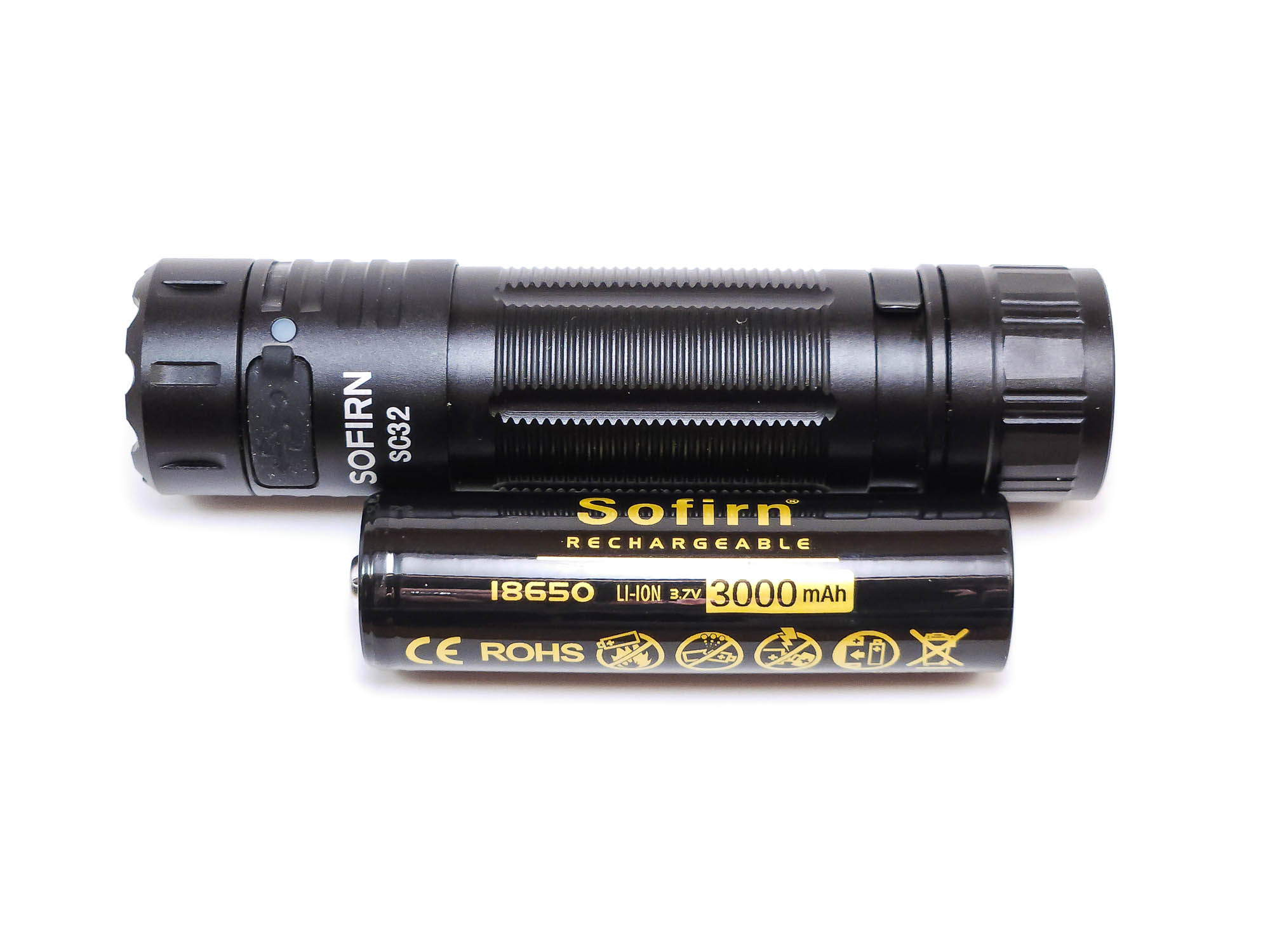
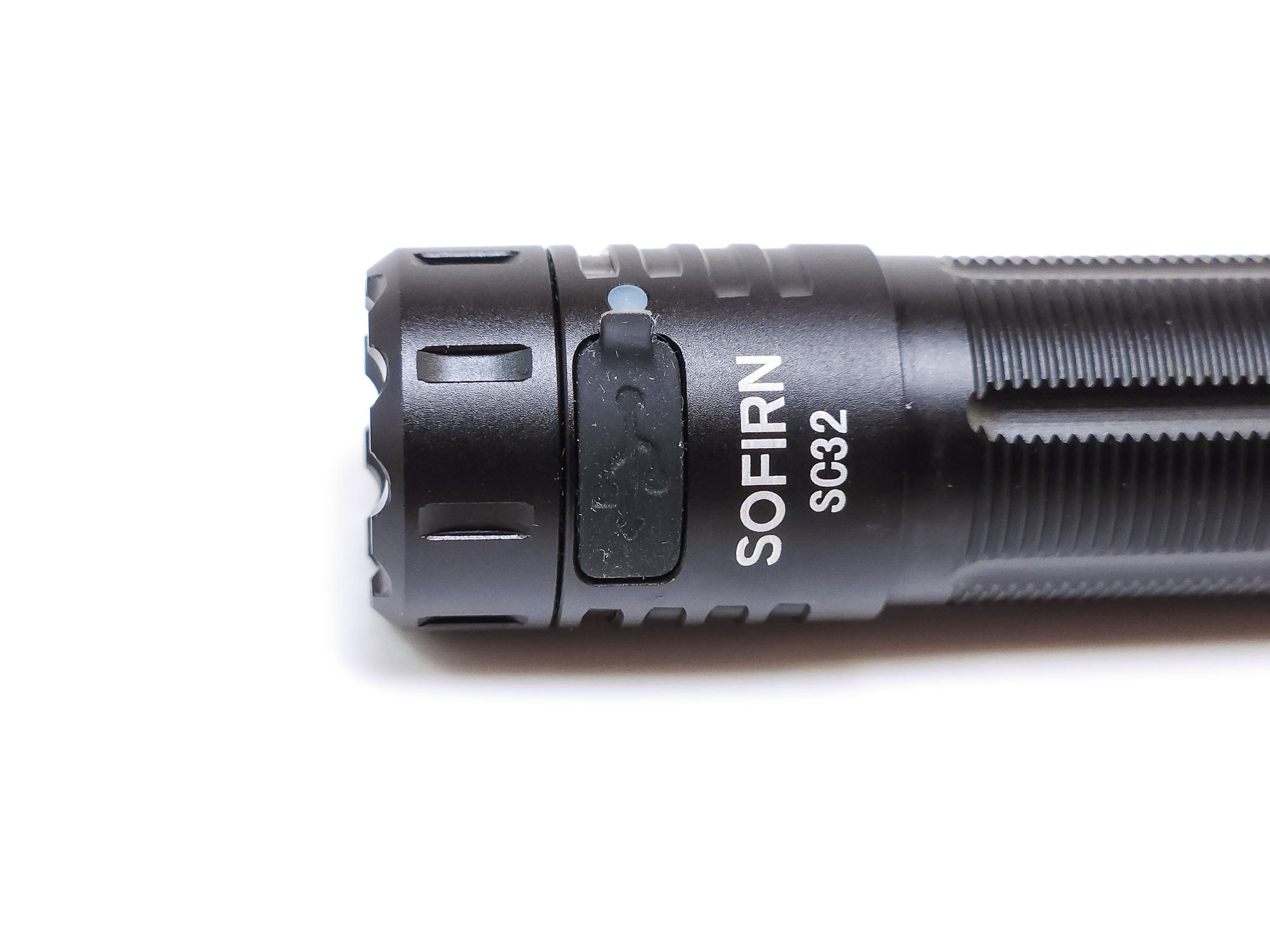
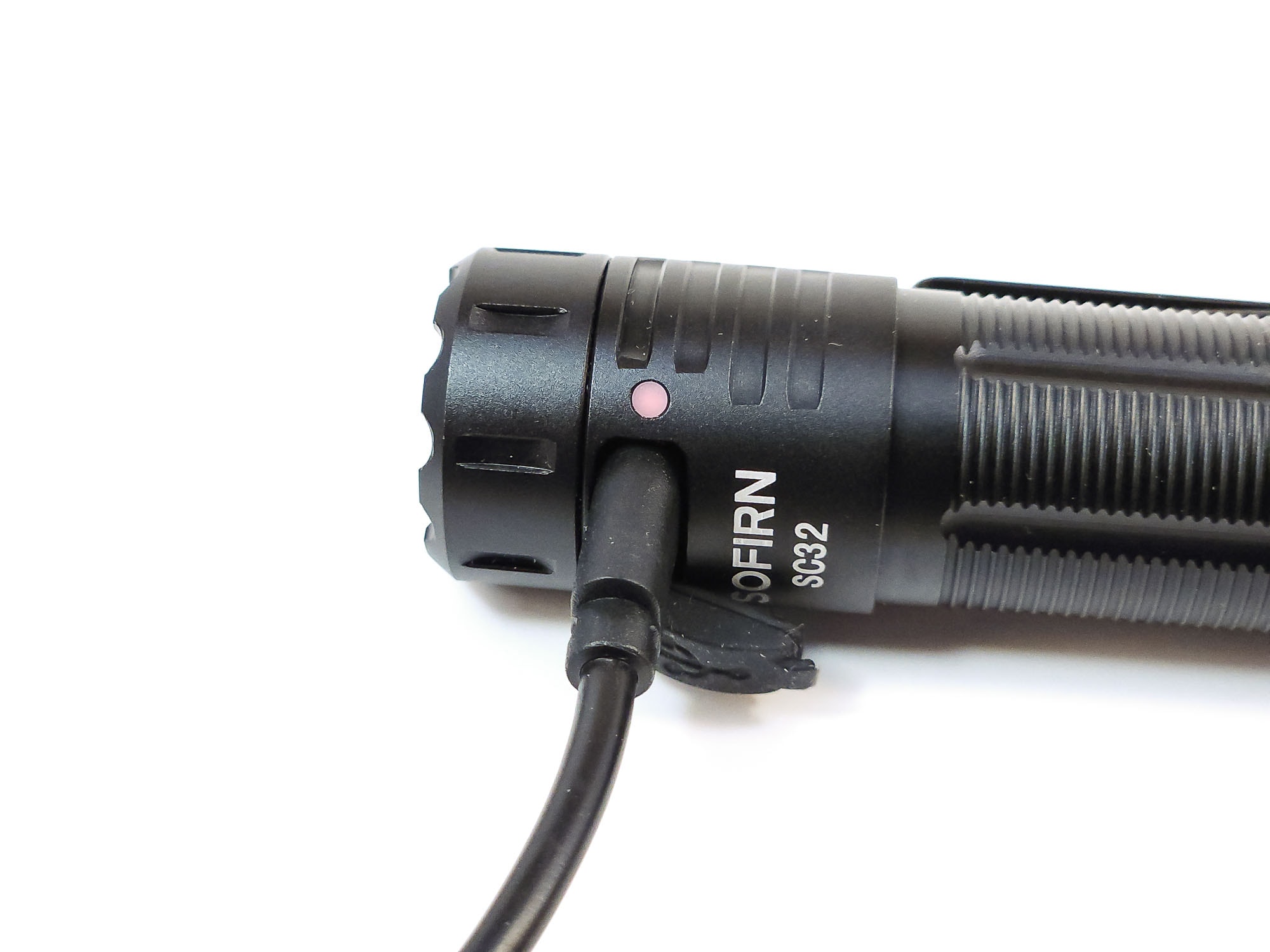
Performance test
To obtain these numbers, I used a very rudimentary integrated shoebox and ceilingbounce on my Samsung Galaxy S10. Measurements have been calibrated using a standardized calibration light provided by 1Lumen.
Unfortunately, it is important to note that the Sofirn SC32 underperforms by about 25% all around. In reality, the visual difference between 1500 and 2000 lumens is hard to discern, but what’s advertised and how it actually does are different things.
Turbo lasts just under a minute while high takes almost three and a half minutes to step down, but they both converge at the medium level, and all three modes stay there for almost 5 hours. Really, aside from the short burst at the beginning, this is a ~300 lumen light. It would’ve been nice to see it sustain high for a bit longer than that.
Another thing that’s a bit annoying is the jump between moonlight and low. The difference between low, medium, high, and turbo is ok, but not having anything between 1 and 90 (advertised) lumens is jarring. If you think accidentally activating a 10-lumen low mode when you’re expecting moonlight is bad, hitting low on the SC32 will leave you blinking for a minute afterward. It’s no better with the smooth ramping mode either, since it’s very hard to get into a level below the stepped low level.
Lumen measurements (for each mode)
| Mode | Specified | turn on | 30 sec | 10 minutes |
|---|---|---|---|---|
| Moon | 1 | 0 lm | 0 lm | 0 lm |
| Low | 90 | 71 lm | 71 lm | 71 lm |
| Med | 450 | 325 lm | 323 lm | 312 lm |
| High | 900 | 680 lm | 661 lm | 308 lm |
| Turbo | 2000 | 1567 lm | 1463 lm | 314 lm |
| Turbo at 3.6V | – | 1180 lm | 1129 lm | 229 lm |
Parasitic drain:
- It’s not possible to measure amps on this light as it requires the body to be disconnected from the head to access the battery.
Battery Life: Runtime graphs
I’m not sure how they measured their runtime with this light, because their high and turbo numbers are nowhere near what I got for ANSI or shut off. On a positive note, my runtimes were much longer than what Sofirn specified.
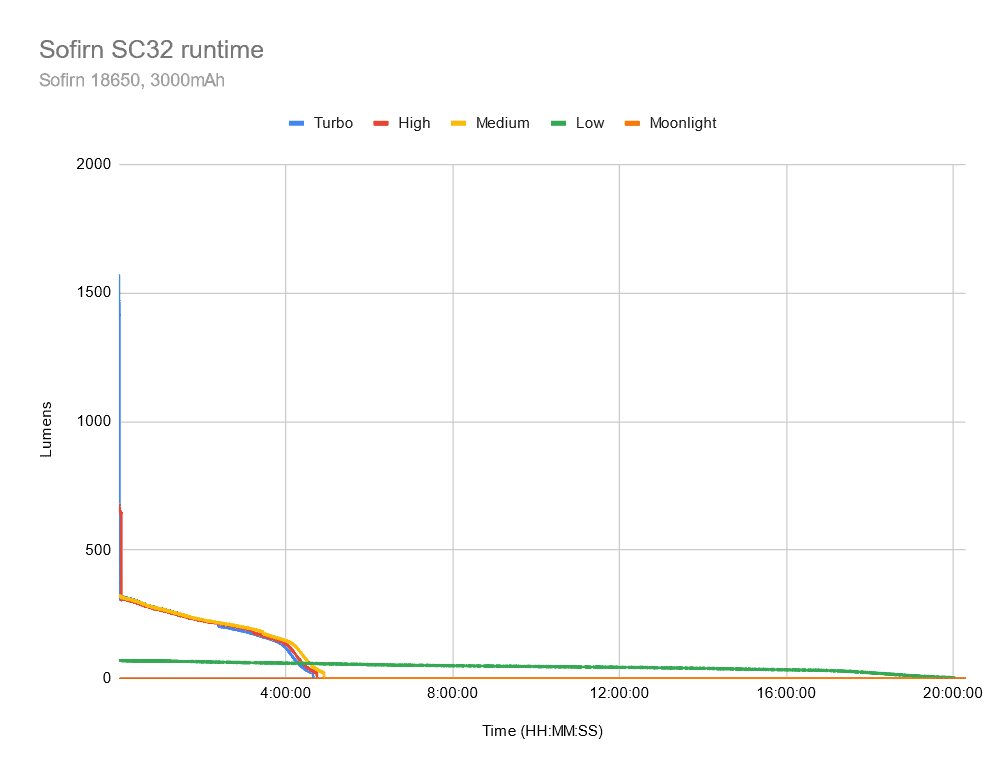
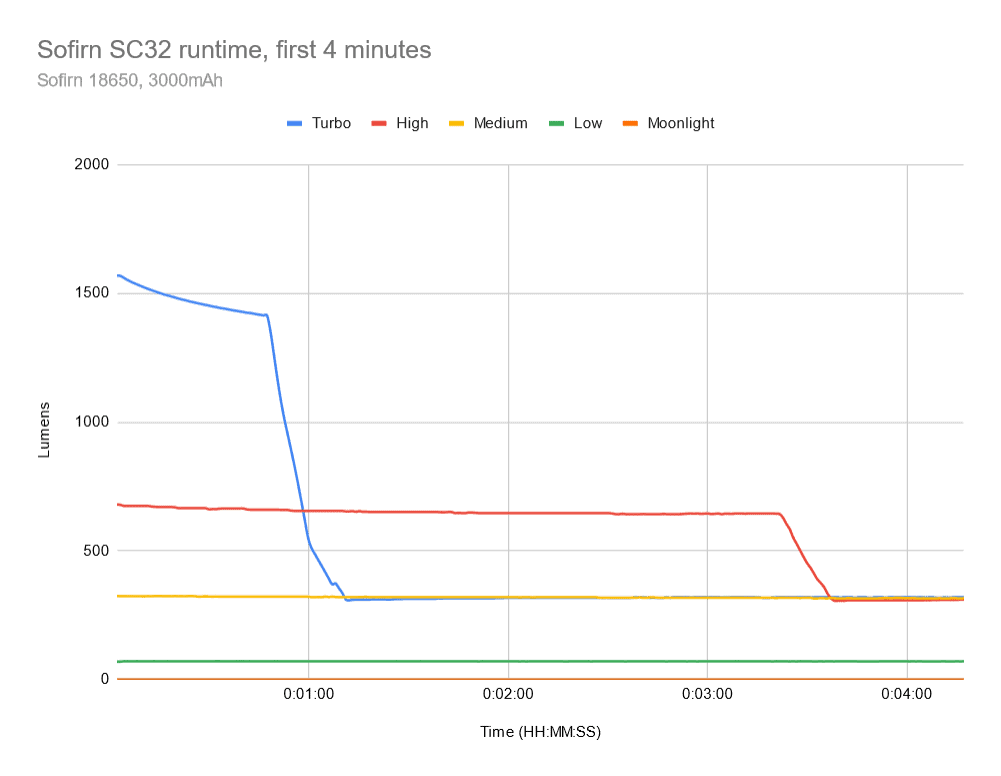
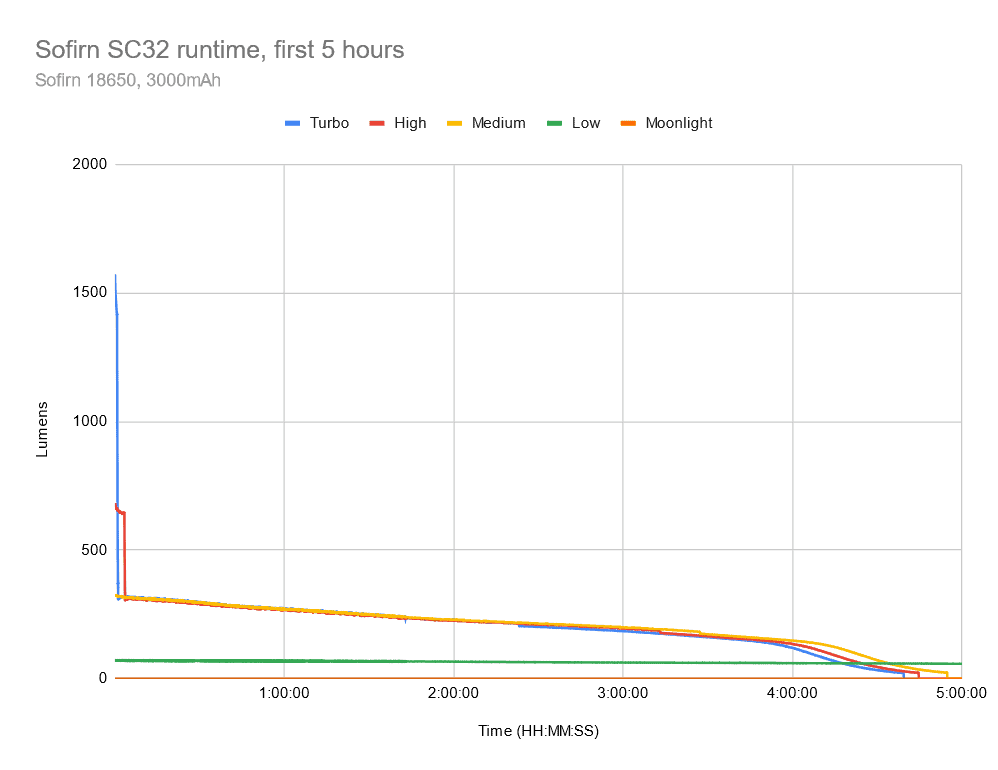
| Mode | Specified | Measured runtime ANSI | Time till shut off |
|---|---|---|---|
| Moon | 500h | – | – |
| Low | 17h | 19h 36min | 20h 02min |
| Med | 4h 12min | 4h 47min | 4h 55min |
| High | 2h 23min | 4h 22min | 4h 44min |
| Turbo | 1h 50min | 3h 36min | 4h 39min |
ANSI FL1 standards: The runtime is measured until the light drops to 10% of its initial output (30 seconds after turning on). This does not mean that the flashlight is not usable anymore. The last column shows how long the light actually works till it shuts off. If there is a + symbol, it means that the test was stopped at that particular point, but the light was actually still running. This happens on certain occasions, with certain drivers, firmware, or batteries.
Peak beam intensity and beam distance measurements
As always, I took my measurements at 30 seconds after turn on. The lowest modes didn’t quite meet specifications, but the fresnel lens proved its worth in the higher modes as I measured over 13,851 cd on turbo, pushing the throw 21 meters farther than spec!
The numbers for candela were obtained with a UNI-T UT383S luxmeter at 5 and 15 meters, then averaged. Low was measured at 1 meter.
| Mode | Specified | Candela measured | Meters | Yards |
|---|---|---|---|---|
| Moon | 9 cd | 4 cd | 4 m | – |
| Low | 600 cd | 583 cd | 48 m | 52 yd |
| Medium | 2725 cd | 2599 cd | 102 m | 112 yd |
| High | 5600 cd | 5873 cd | 153 m | 167 yd |
| Turbo | 11425 cd | 13,851 cd | 235 m | 257 yd |
| Turbo (at turn on) | – | 14,189 cd | 238 m | 260 yd |
Extra info: Peak beam distance according to ANSI FL1 standards: The calculated value of distance in meters at which the flashlight produces a light intensity of 0.25 lux. (0.25 lux is about the brightness of a full moon shining on an object). The columns ‘Meters’ and ‘Yards’ use rounded numbers.
Beamshots
These were taken with a Samsung Galaxy S22+ using pro mode and the following settings:
- WB 5000K
- ISO 200
- Speed 0.5
Beamshots of the following flashlights compared:
- Sofirn SC32
- Sofrin SC31T Pro
- Sofirn SC18
As you can see, the fresnel lens gives the SC32 a bigger hotspot than the other Sofirns I compared it to, but it lacks the lower powered spill.
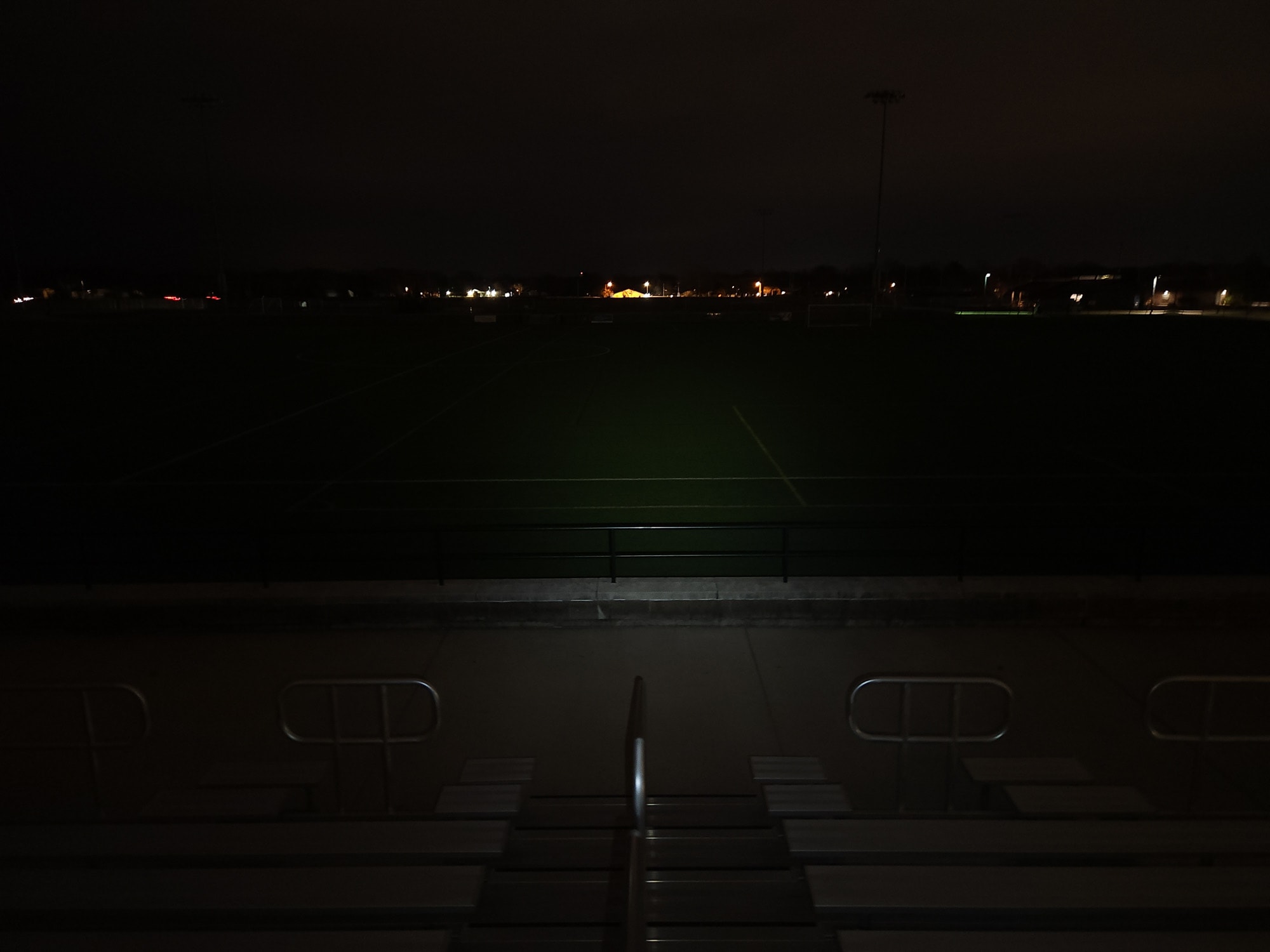
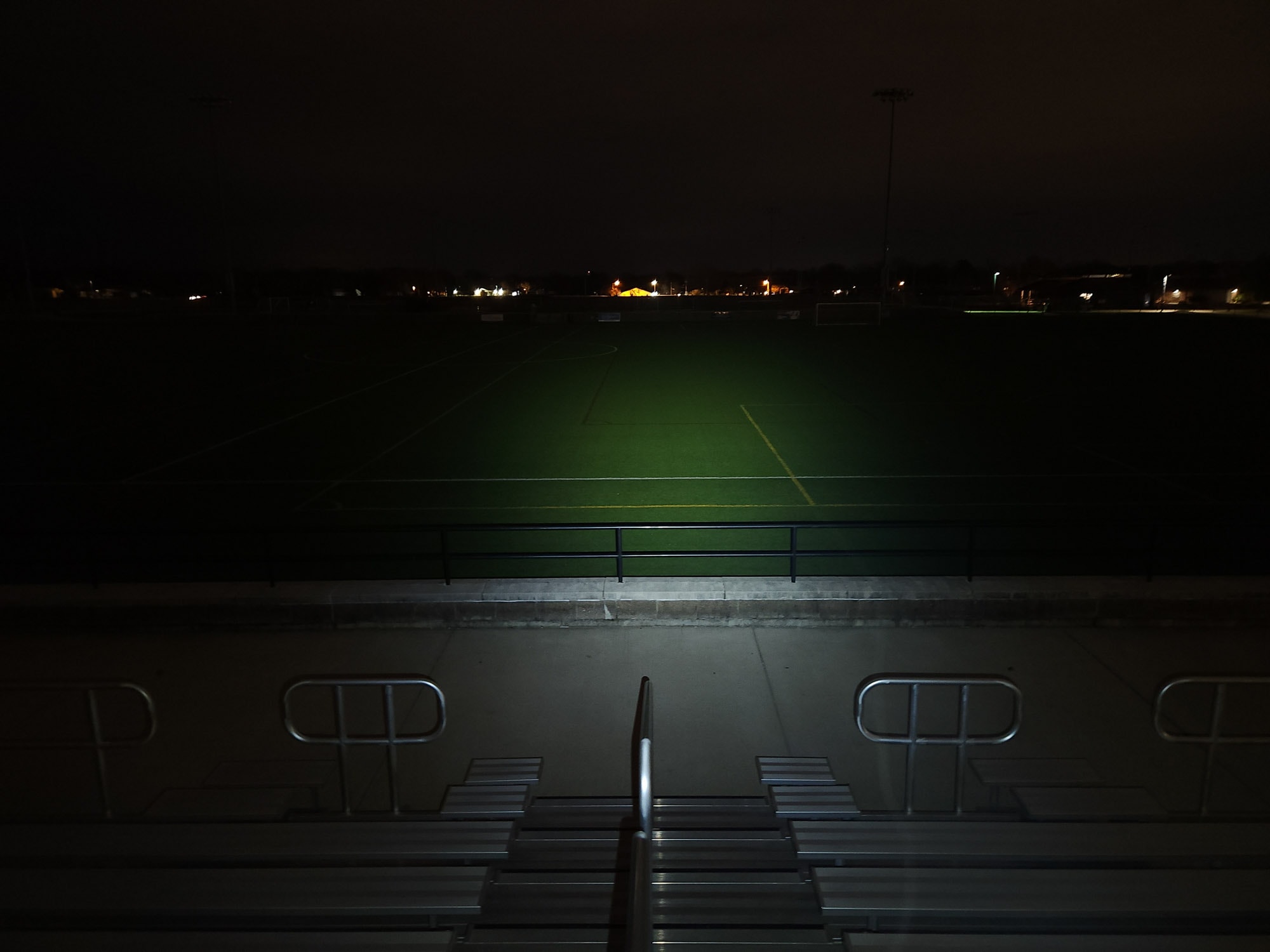
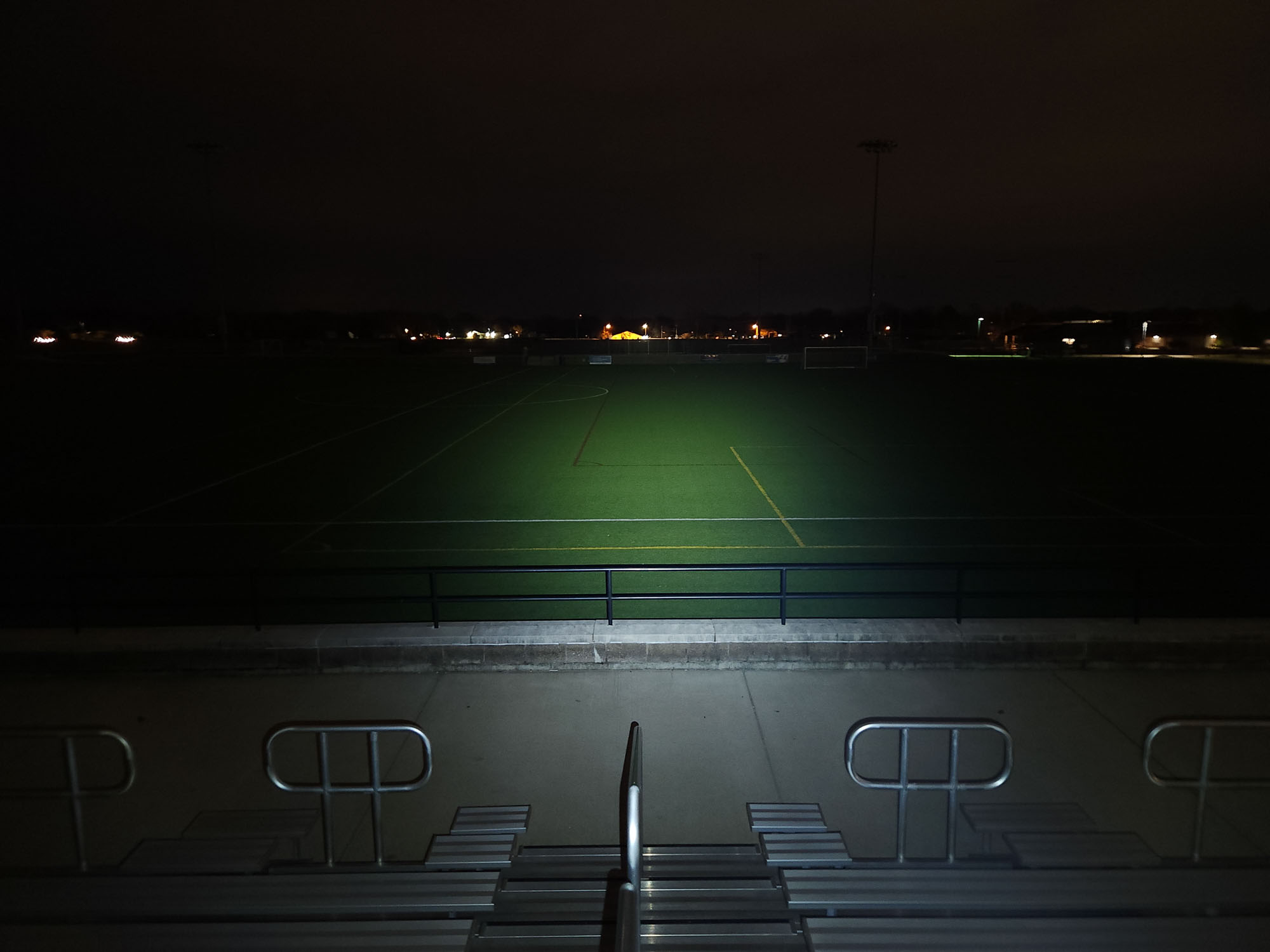
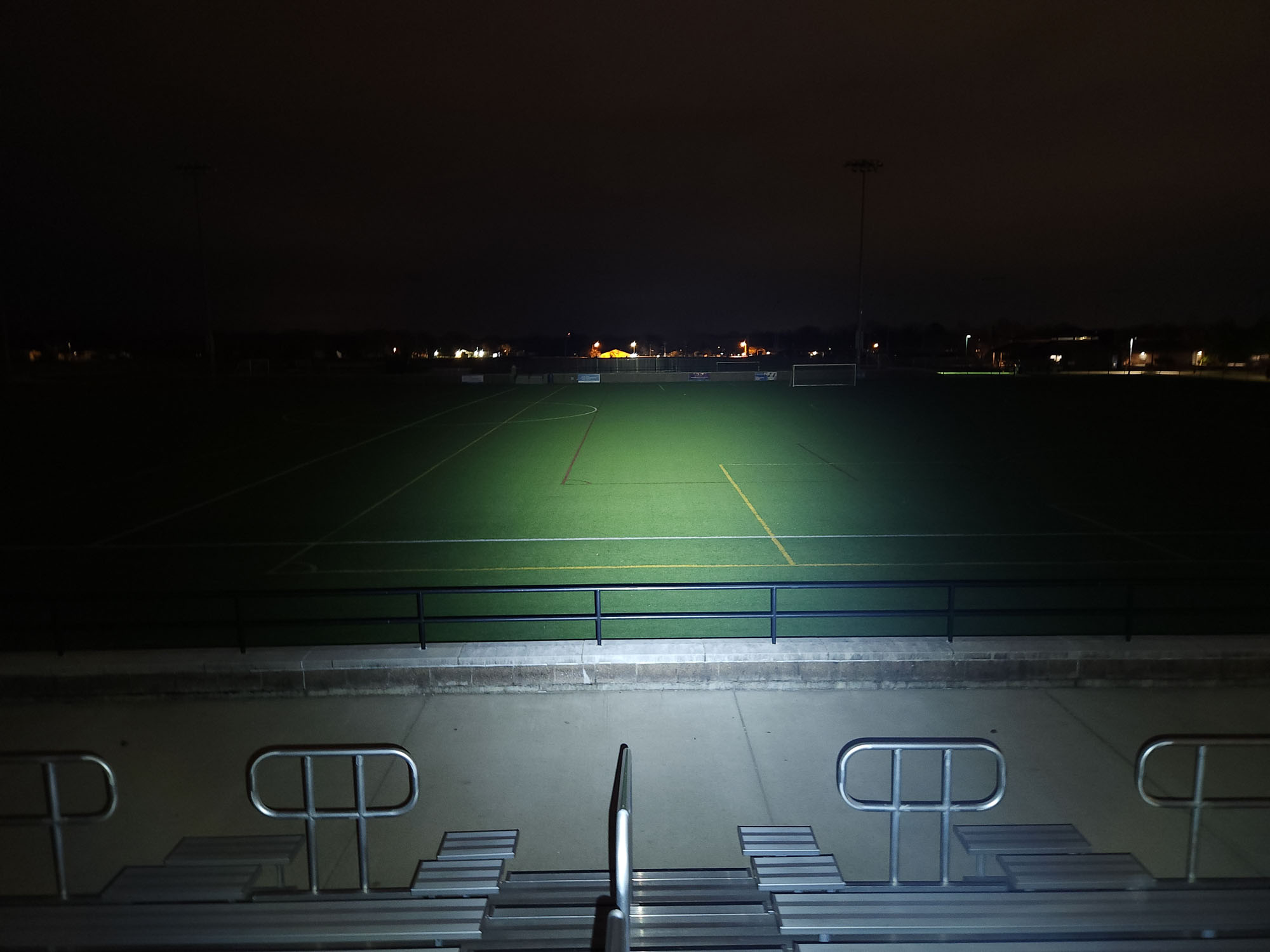
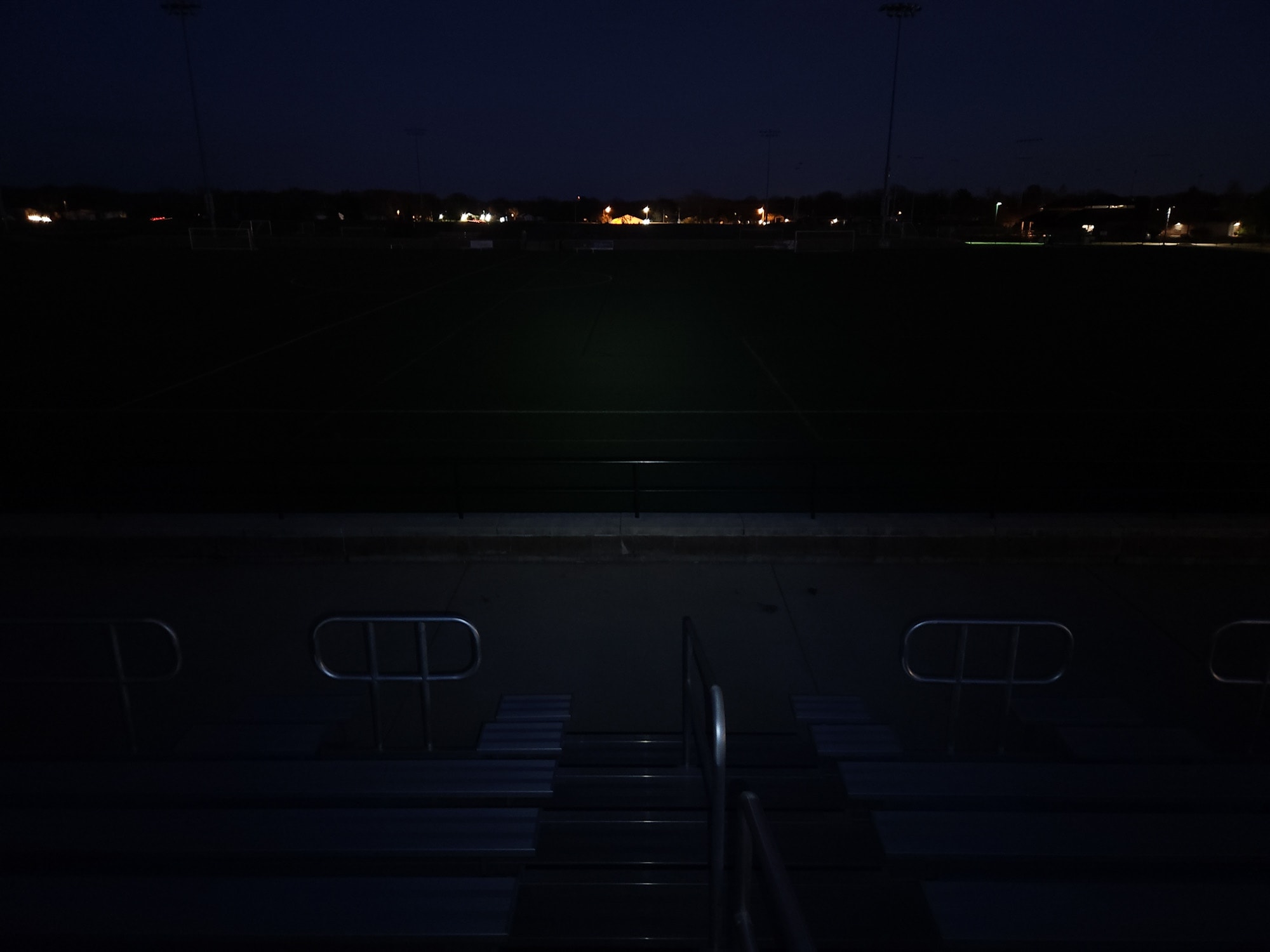
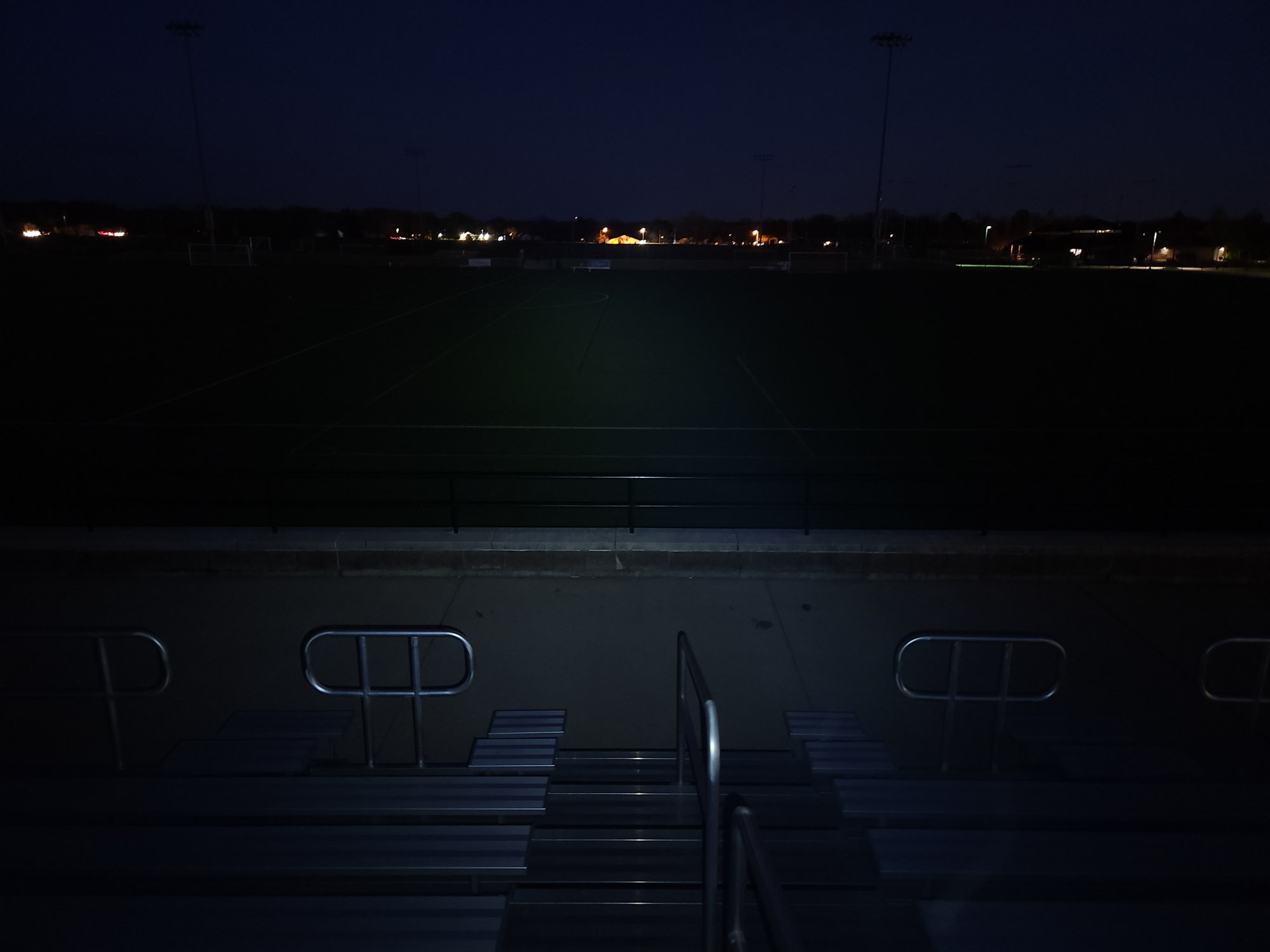
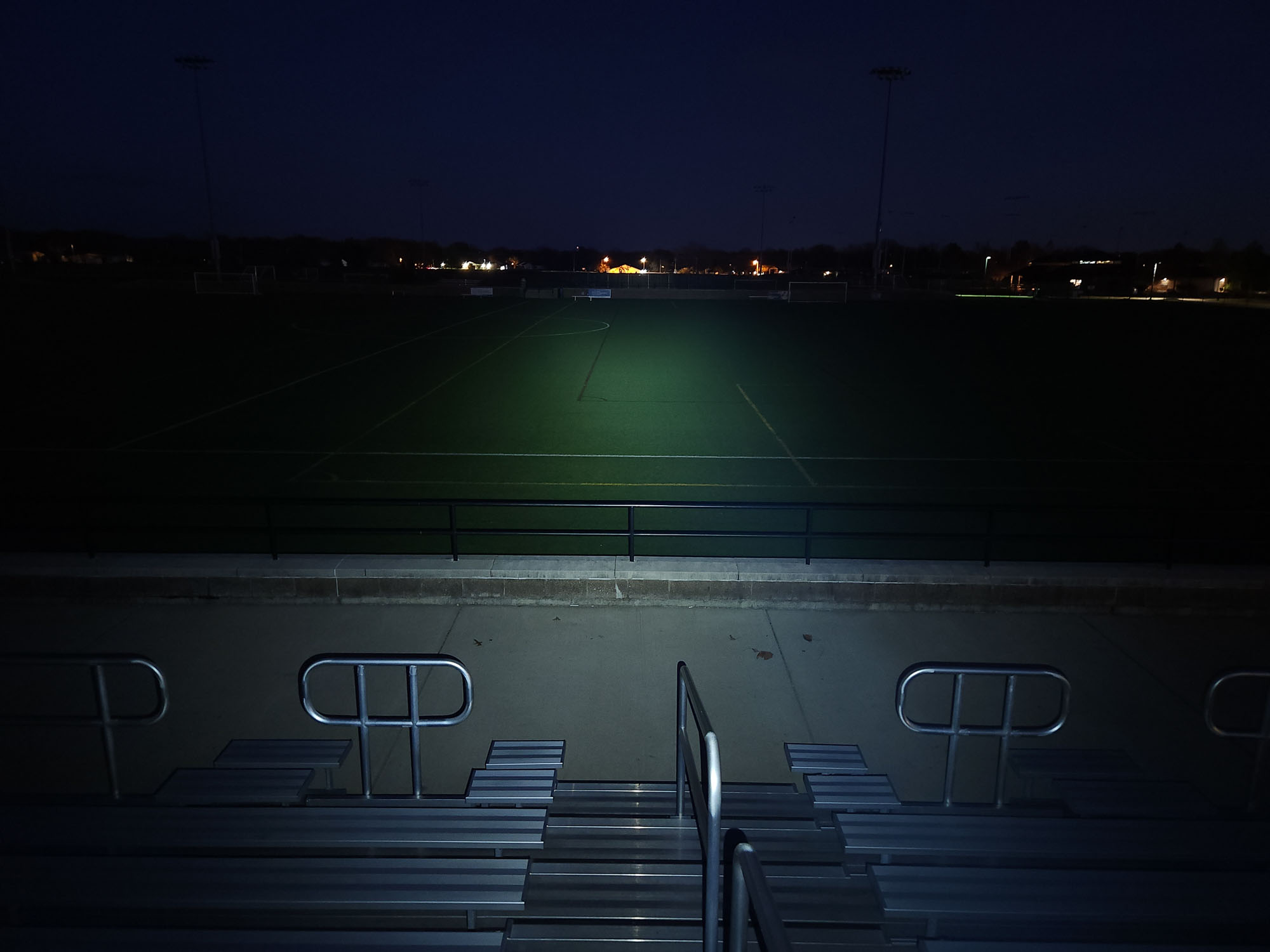
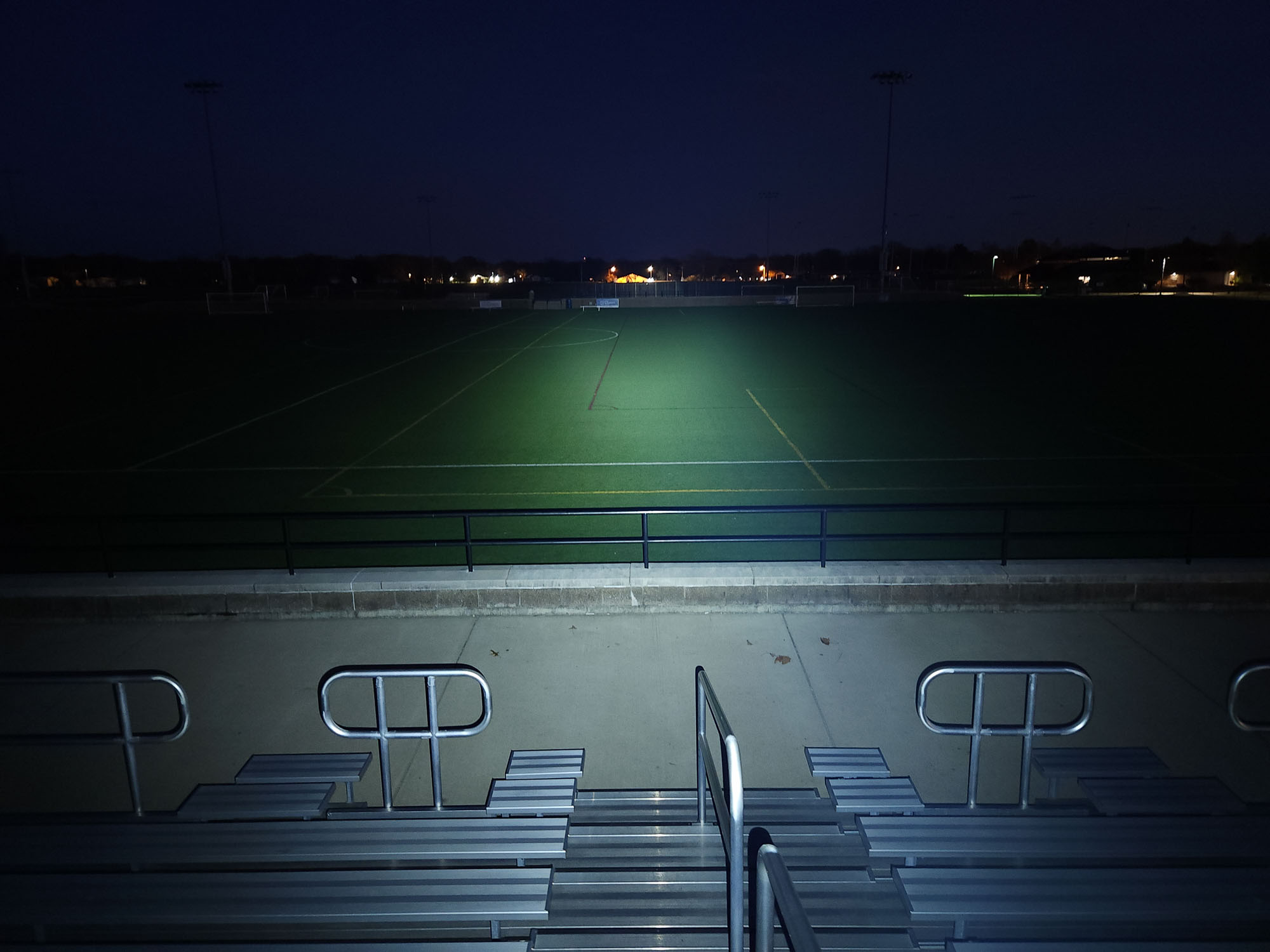
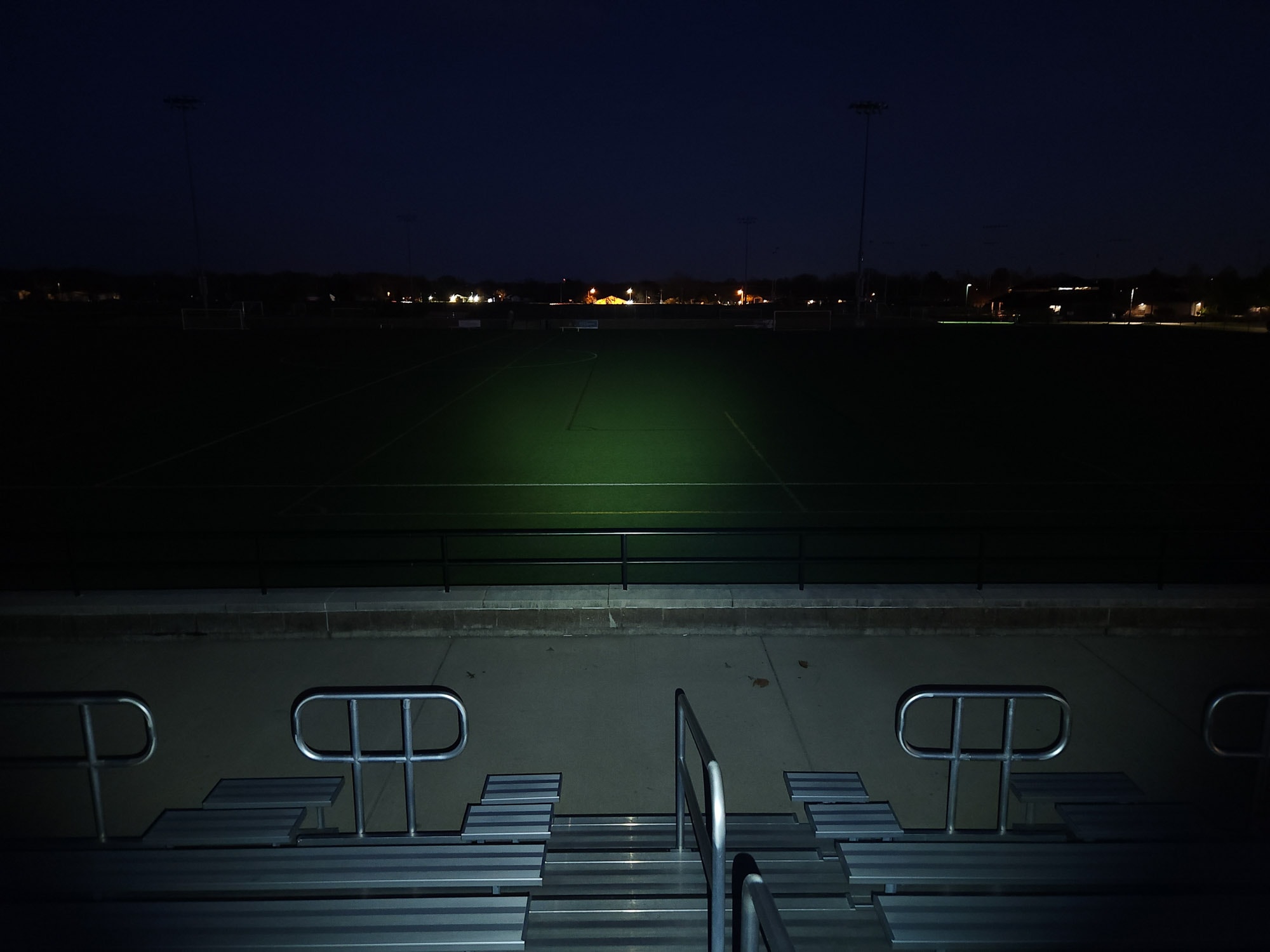
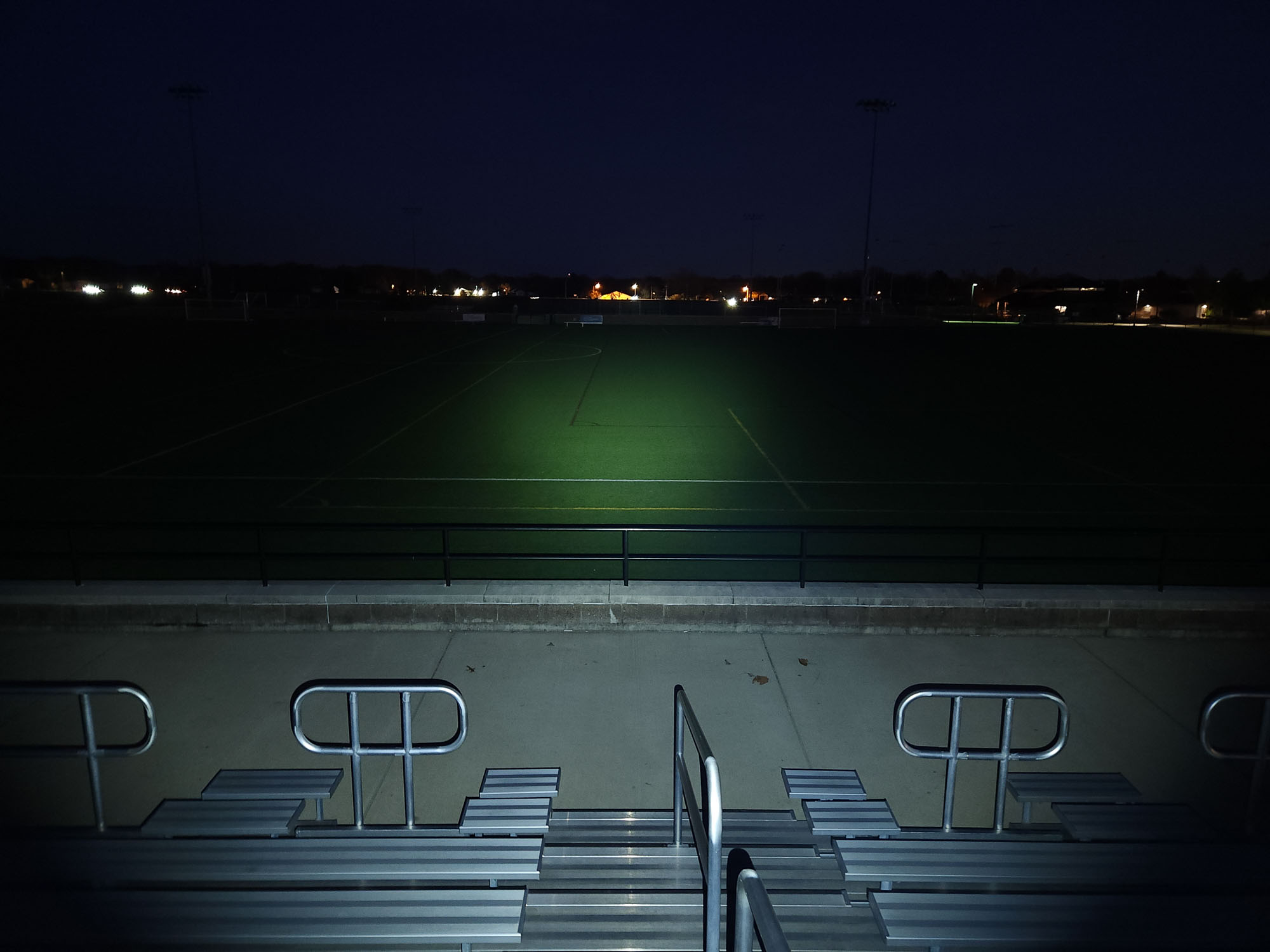
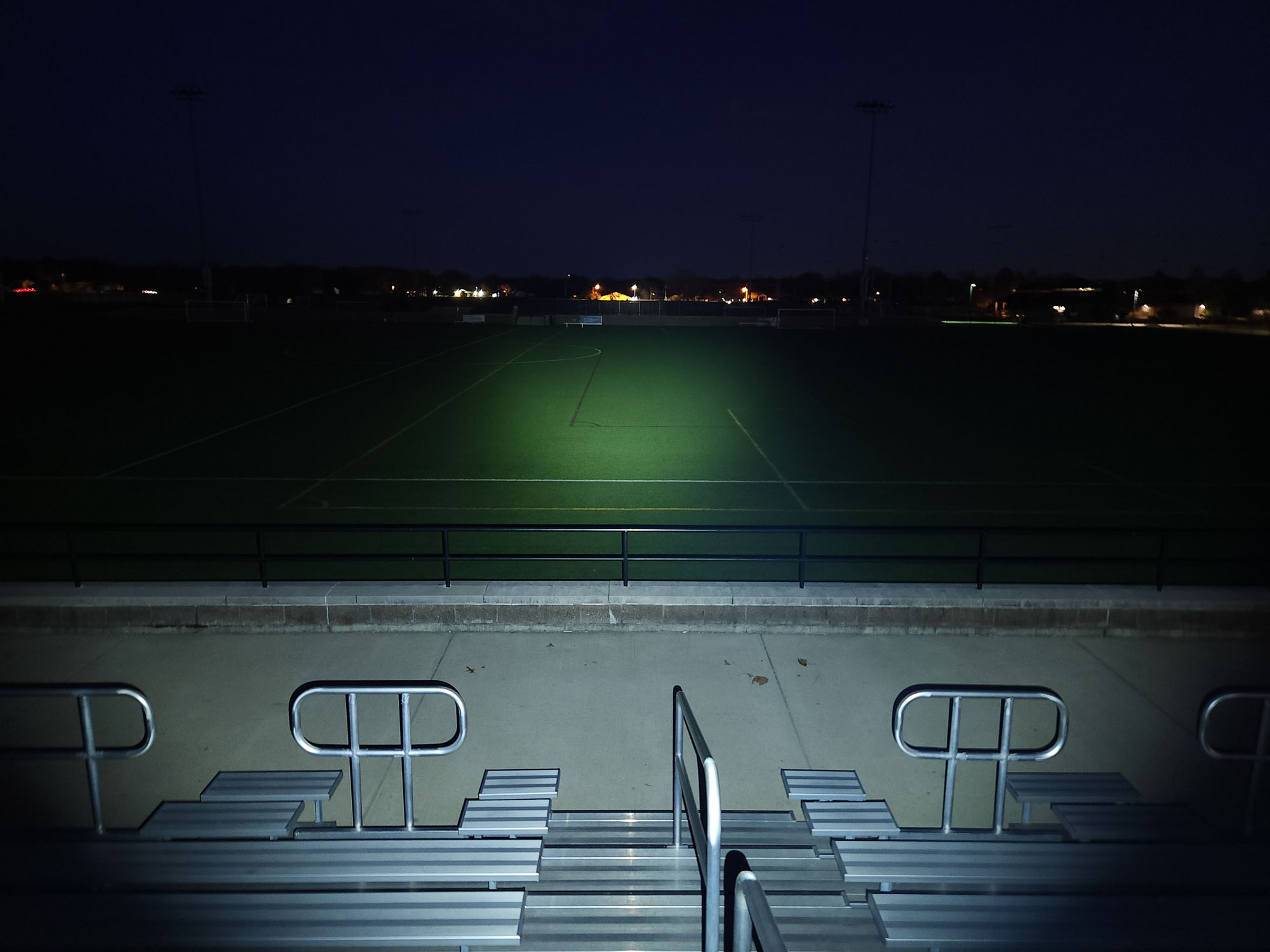

Disclaimer: This flashlight was sent to me for review at no cost by Sofirn. I have not been paid to review, nor have I been holding back on problems or defects.
Final Verdict
Pros
- Full package with battery and charging
- Compact
- Fresnel lens throws well
- Momentary moonlight from lockout
Cons
- Parts of the UI are not intuitive, like getting out of turbo and ramping direction memorization
- Measurements strangely different than spec
- I disagree with the “tactical” branding
Explanation on star ratings:
1: Avoid: a match would be a better choice – 2: Poor: significant defect or issues; almost unusable – 3: Average: some defects or issues; but still usable 4: Good: recommended (minor issues) – 5: Great: highly recommended

4 stars: ★★★★
Let’s get one thing out of the way first: An electronic tail switch light is not tactical. There are just too many options besides the simple turbo on/off that defines a tactical light. That’s not to say the SC32 is bad; it’s pretty good! It’s very compact and one of the smallest 18650 lights I own! The fresnel lens is also nice and helps push the throw out farther than expected. Now, the electronic tail switch is a different take for Sofirn, and a little bit of a mixed bag. While I found the switch itself to be good and never had it turn on in my pocket, the UI needs some work where turbo and ramping are concerned.
Not taking Sofirn’s tactical designation into account, I give the SC32 four stars. If you need a pocketable light with a pretty decent throw, you might want to consider the Sofirn SC32. If it’s a tactical light you need, you’ll have to look elsewhere.
Sofirn SC32 for sale
1lumen selects and reviews products personally. We may earn affiliate commissions through our links, which help support our testing.